
- Introduction: A Quick Trip To Japan & Korea
- Review: Alaska First Class Boeing 737 MAX (FLL-SEA)
- Review: Fairmont Vancouver Airport (YVR)
- Review: SkyTeam Lounge Vancouver Airport (YVR)
- Review: Korean Air Business Class Boeing 787-10 (YVR-ICN)
- Review: Grand Hyatt Incheon Airport (ICN)
- Review: Korean Air Prestige Business Lounge Seoul Incheon Airport (ICN)
- Review: Korean Air Business Class Airbus A321neo (ICN-CTS)
- Review: Japan Airlines Diamond Premier Lounge Sapporo Airport (CTS)
- Review: Japan Airlines Domestic First Class Airbus A350 (CTS-HND)
- Review: First Cabin Tokyo Haneda Airport (HND)
- Review: Japan Airlines Business Lounge Tokyo Haneda Airport (HND)
- Review: Japan Airlines Sakura Sky View Lounge Tokyo Haneda Airport (HND)
- Review: Japan Airlines Business Class Airbus A350-1000 (HND-JFK)
For the next segment of my quick trip to Japan & Korea, I flew Japan Airlines’ Airbus A350-900 first class on the 1hr30min flight from Sapporo (CTS) to Tokyo Haneda (HND). It’s not often that I look forward to domestic flights, but this was an exception.
Most OMAAT readers are probably familiar with the incredible Japan Airlines A350-1000 first class, which I rank as being among the best in the world. However, the airline also has a fleet of A350-900s, which are used exclusively for domestic flights, and that’s what I had on this sector.
Keep in mind these huge jets primarily operate flights that are at most two hours, so of course it’s a completely different experience than on long haul flights. I think Japan Airlines absolutely nails the domestic first class product, from the free Wi-Fi and tail camera, to the super friendly service, to the seat comfort. This has to be one of the best value premium products out there, given the low pricing.
In this post:
How I booked my Japan Airlines first class ticket
I booked my entire ticket from Sapporo to New York using American AAdvantage miles in business class. Specifically, I booked the following in business class for 60,000 American AAdvantage miles plus $45.41 in taxes & fees:
10/08 JL526 Sapporo to Tokyo Haneda departing 8:05PM arriving 9:45PM
10/09 JL6 Tokyo Haneda to New York departing 11:05AM arriving 11:00AM
Now here’s the thing — when you book an international business class award on Japan Airlines, the domestic segment books into “Class J.” Despite the branding, this isn’t actually business class. It’s more like a premium economy hard product with an economy soft product.
The good news is that Japan Airlines has an amazing day of departure first class upgrade program. Within three hours of departure, you can upgrade to any available first class seat. My upgrade could be processed in the lounge, and the Class J to first class upgrade cost 8,000 JPY (~54 USD). That was money well spent!

Japan Airlines first class lounge & boarding
In the previous installment I reviewed the Japan Airlines Diamond Premier Lounge Sapporo, which is a nice facility. You can access it with a first class ticket, or with oneworld Emerald status.
My 8:05PM flight was scheduled to board at 7:50PM from gate 16. That’s right, Japan Airlines starts boarding its 369-seat A350-900s just 15 minutes before departure on domestic flights… and flights even manage to depart on-time!
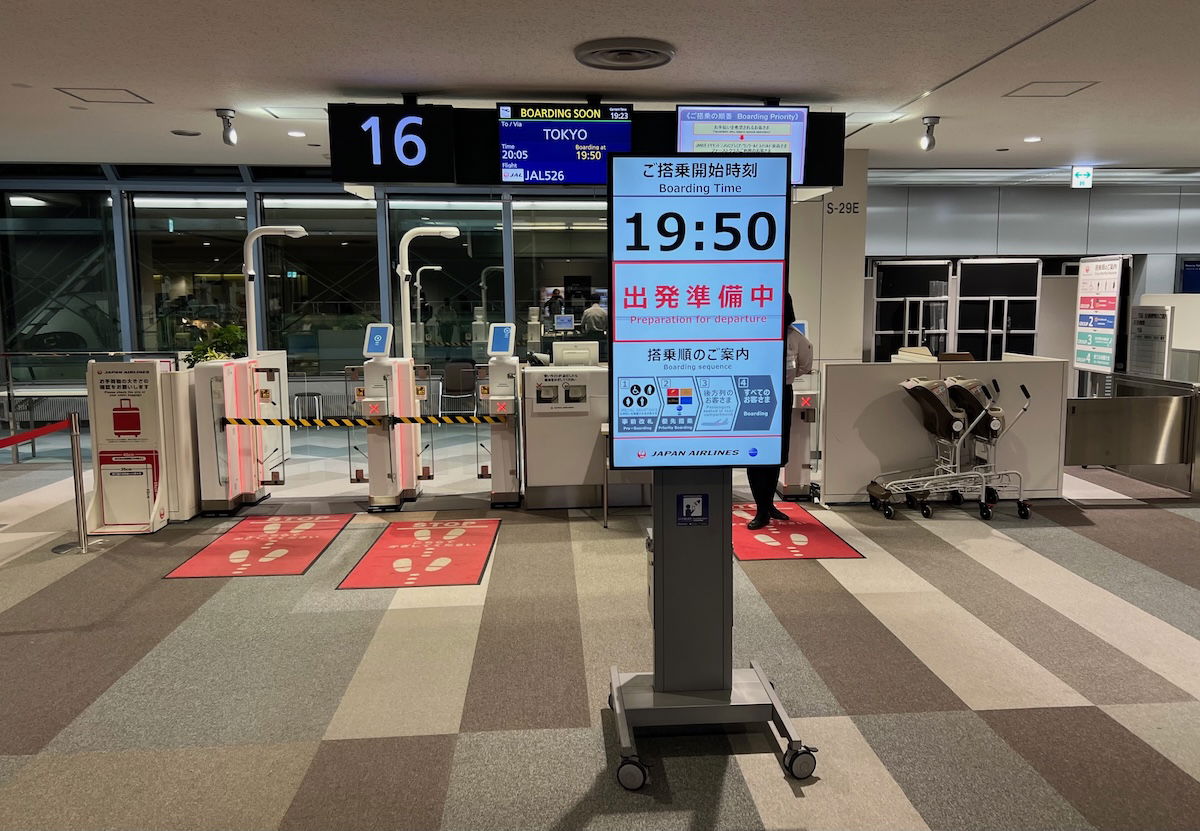
Sure enough, that’s exactly when boarding started, with first class passengers, as well as oneworld Emerald and Sapphire members, being invited to board first. Interestingly Class J passengers without status board last, since boarding is otherwise back to front.
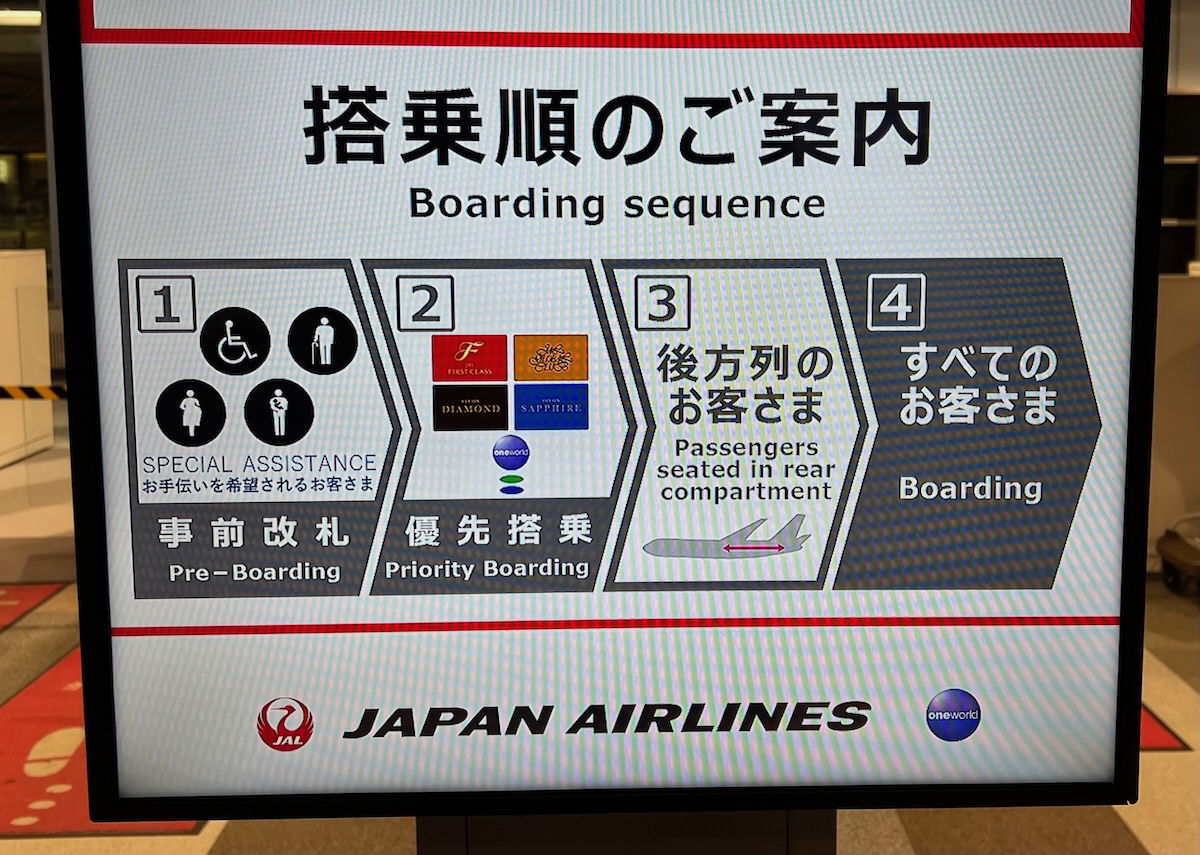
Japan Airlines A350-900 first class cabin & seats
I boarded the Japan Airlines Airbus A350-900 through the forward door, and turned right into the first class cabin. The first class cabin on these domestic jets is pretty intimate, with just 12 seats, spread across two rows, in a 2-2-2 configuration.
Japan Airlines’ domestic A350 first class seats are unique, as you won’t find this product on any other airline. The shell recliner seats are produced by JAMCO, with a design by Tangerine. Seats feature 53″ of pitch and 20″ of width, so they’re quite spacious for the short flights that this plane operates.
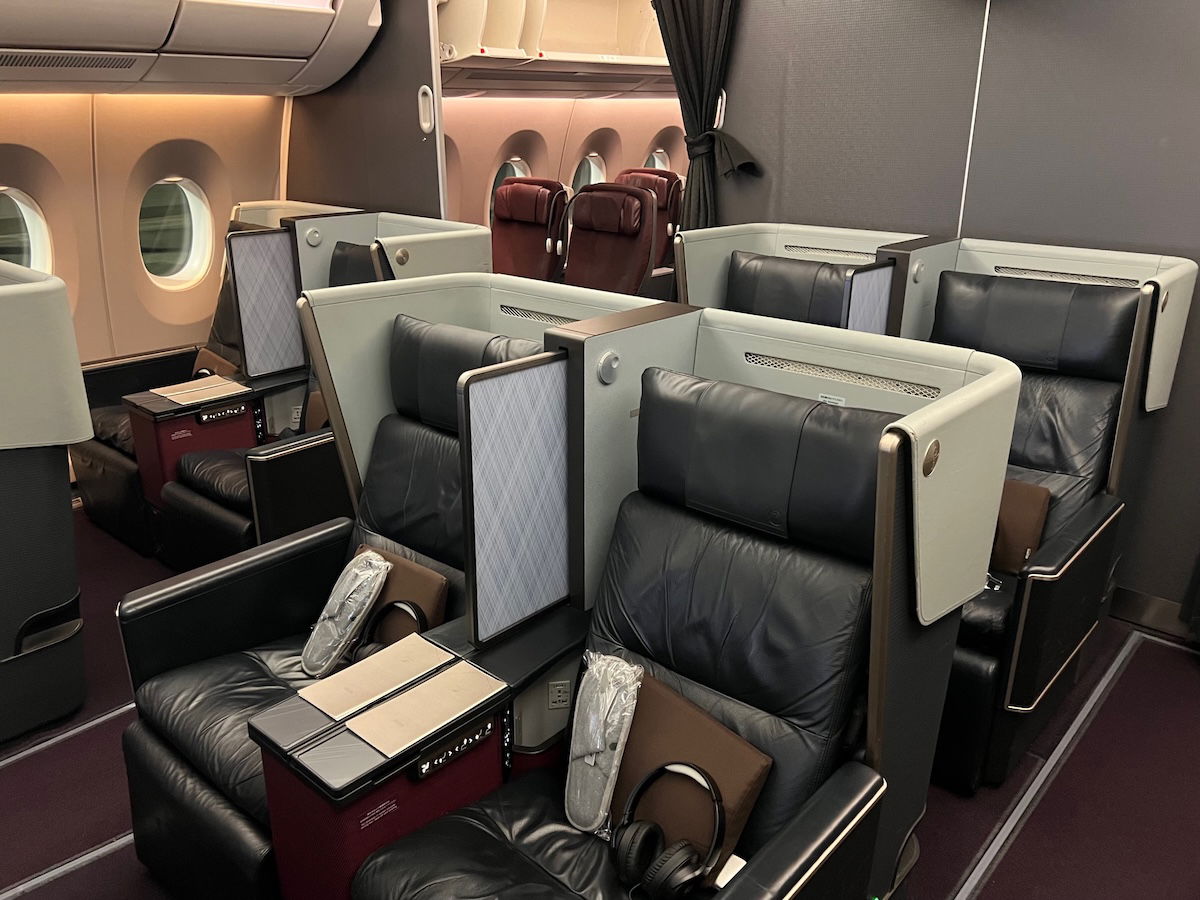
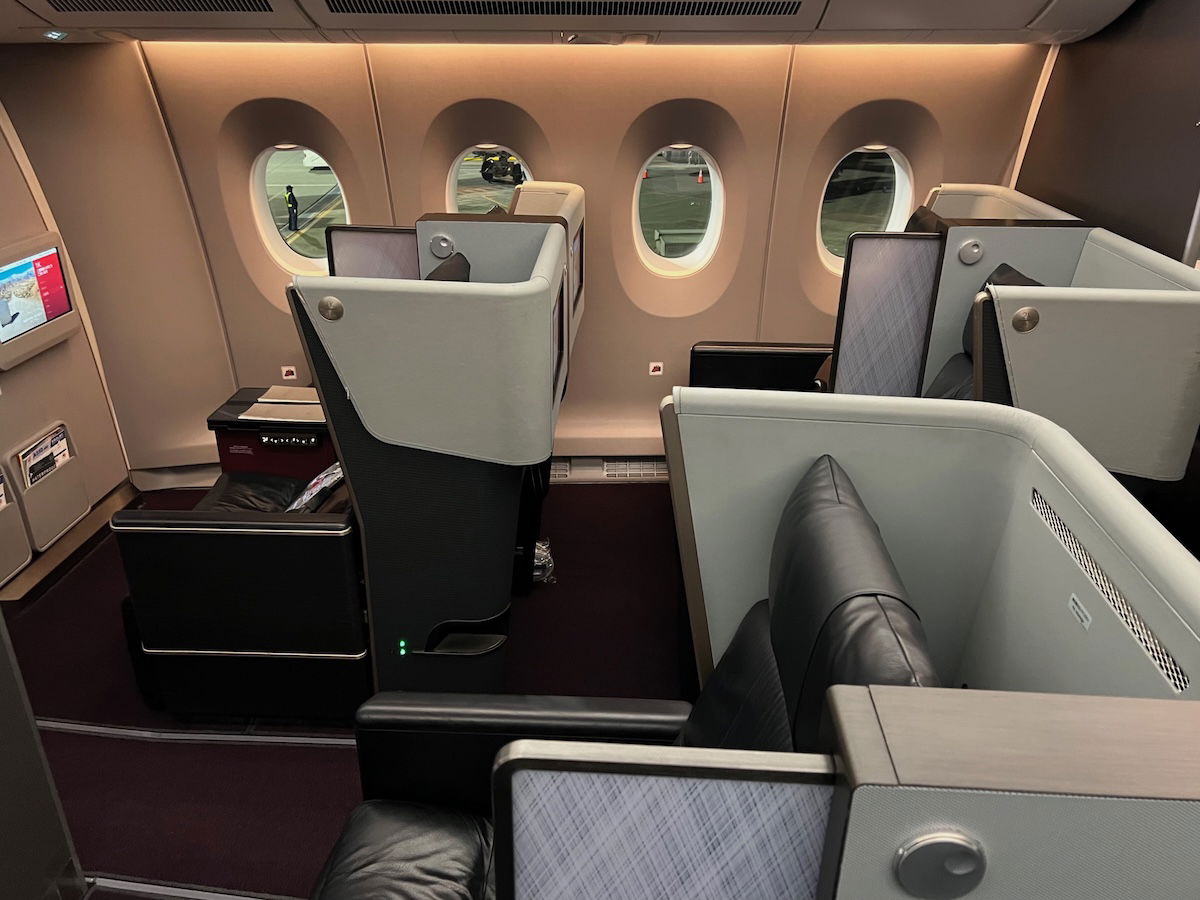
I’m not sure there are any seats in the cabin that are materially better than others, though I do think the window seats would be my first pick, given what a scenic country Japan is, and how much there is to see when flying within the country.
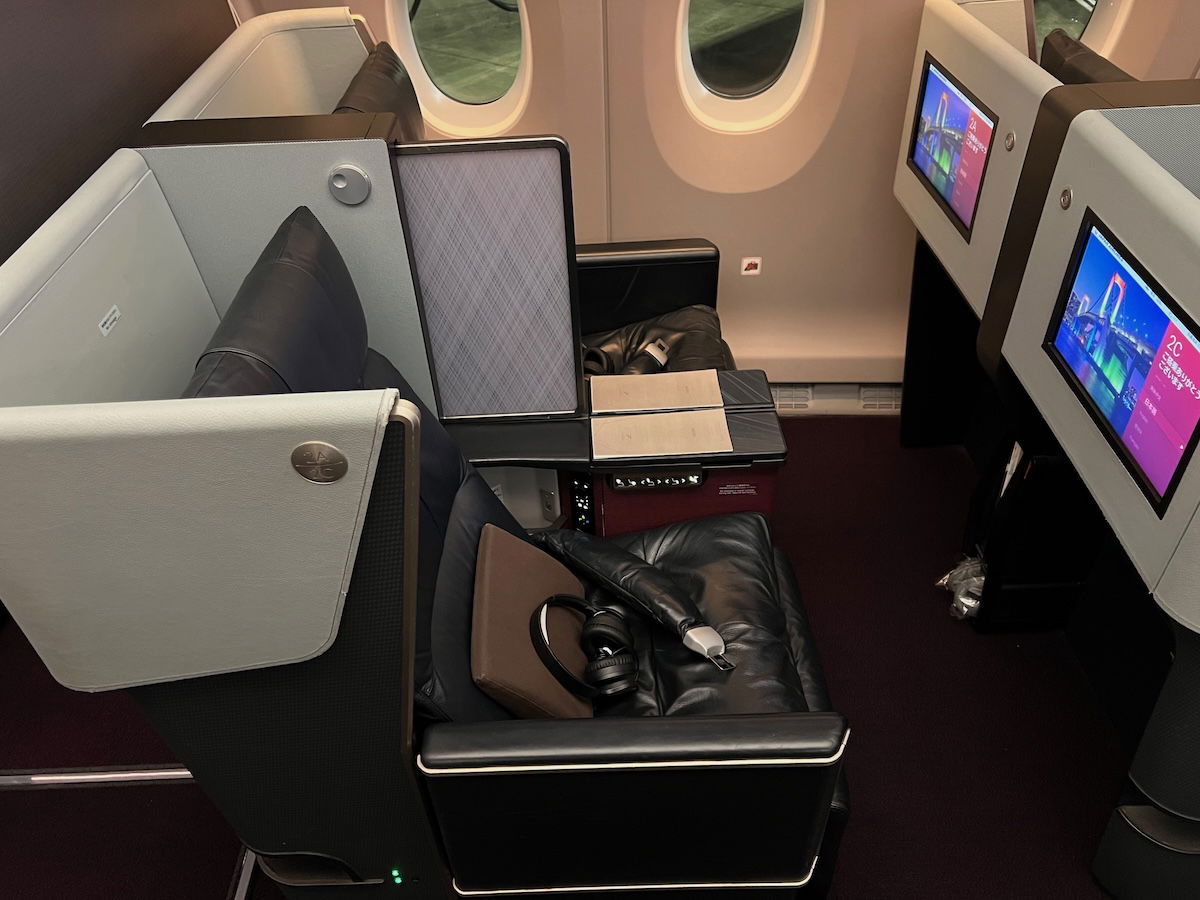
The center pairs of seats have the advantage of each offering access to the aisle, without anyone stepping over you. I was assigned seat 2D, the center left seat in the second row of first class (I’m usually a window seat guy, but there were none available when I purchased my upgrade).
Upon sitting down in the seat, the first thing I noticed is just how well padded these seats are. These must be among the most comfortable seats in the sky for lounging. As you can see, each pair of first class seats also have a partition between them, which can be extended or retracted, depending on whether you’re traveling alone or with a companion.
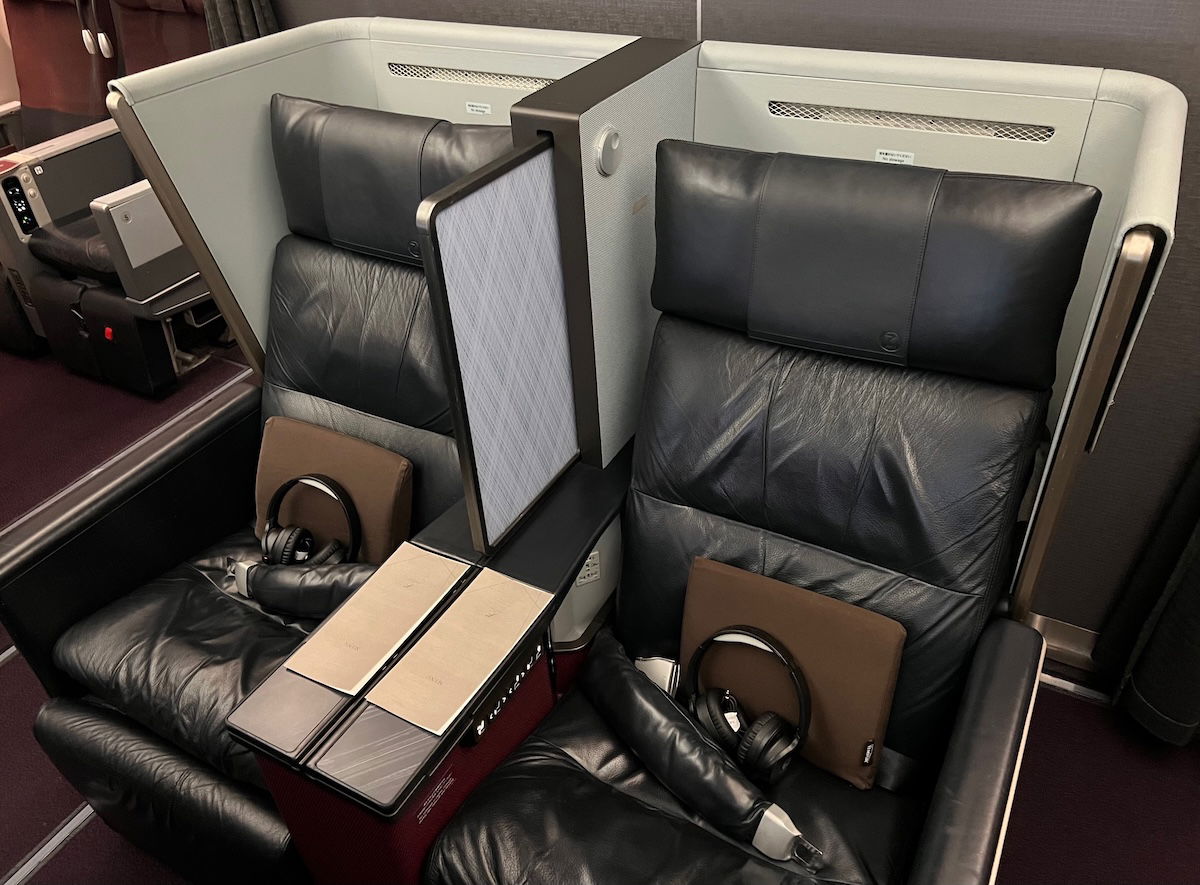
Each seat has a tray table, stored in the armrest, which needs to be folded over to be fully extended.
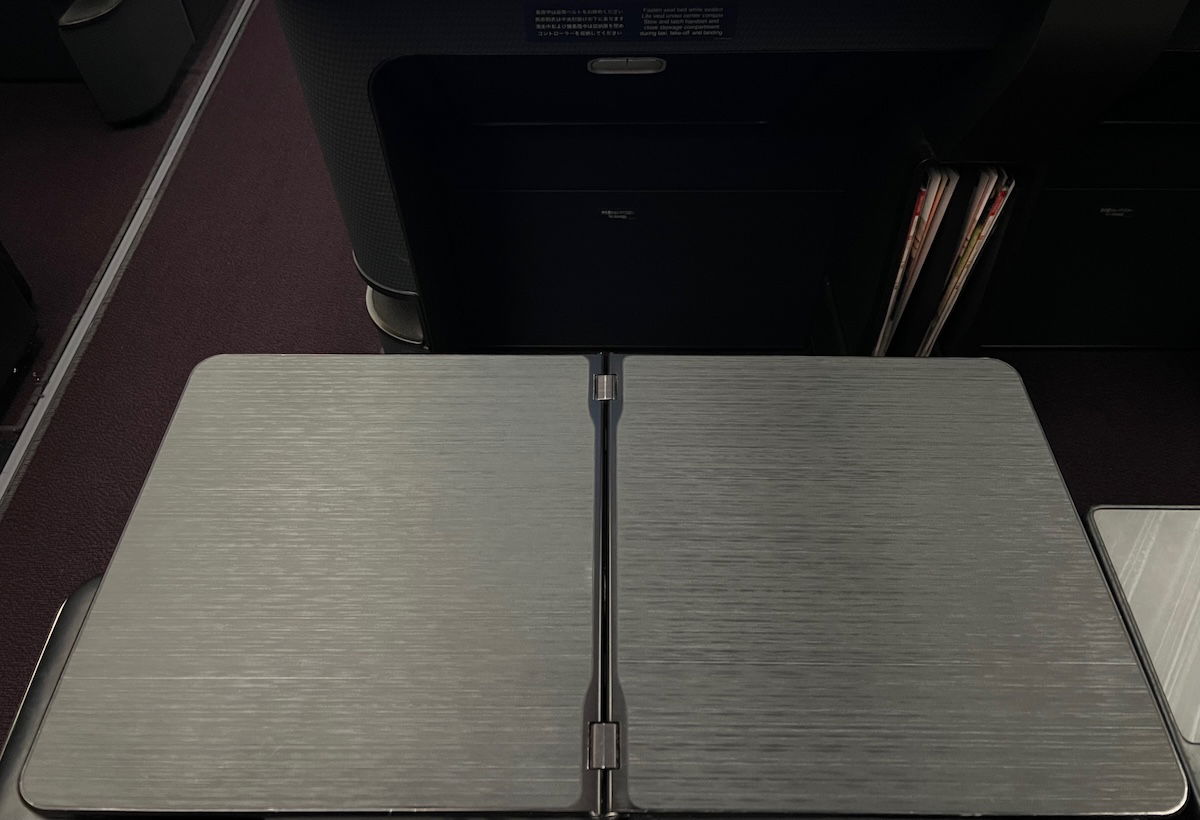
Underneath the center armrest are the seat controls, which are easy to use. This seat obviously doesn’t turn into a fully flat bed, but rather you can choose to adjust the seat back or the foot rest, both of which move a fair bit.

There’s also an entertainment controller there, which I consider to be unnecessary, given that the video screen can also be controlled by touch.
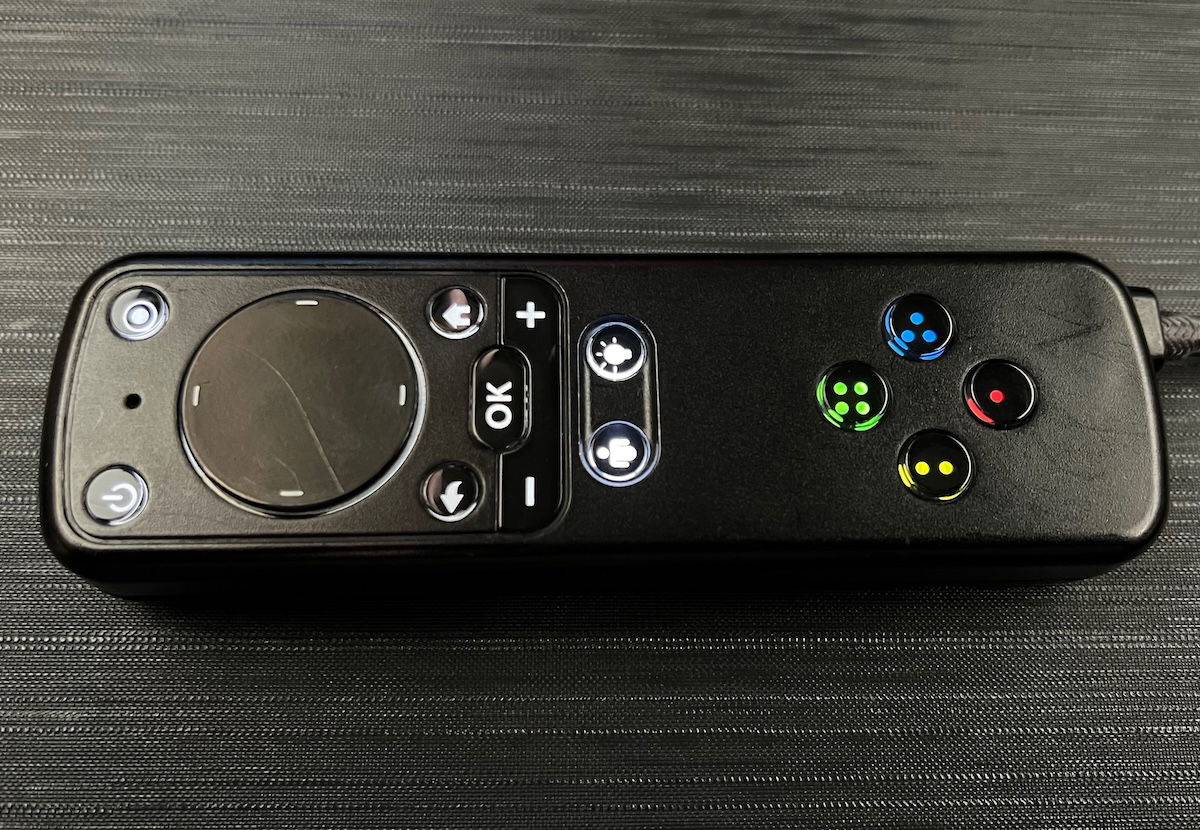
Underneath that area is a small exposed storage area, where you’ll also find AC and USB-A outlets, plus a headphone jack.
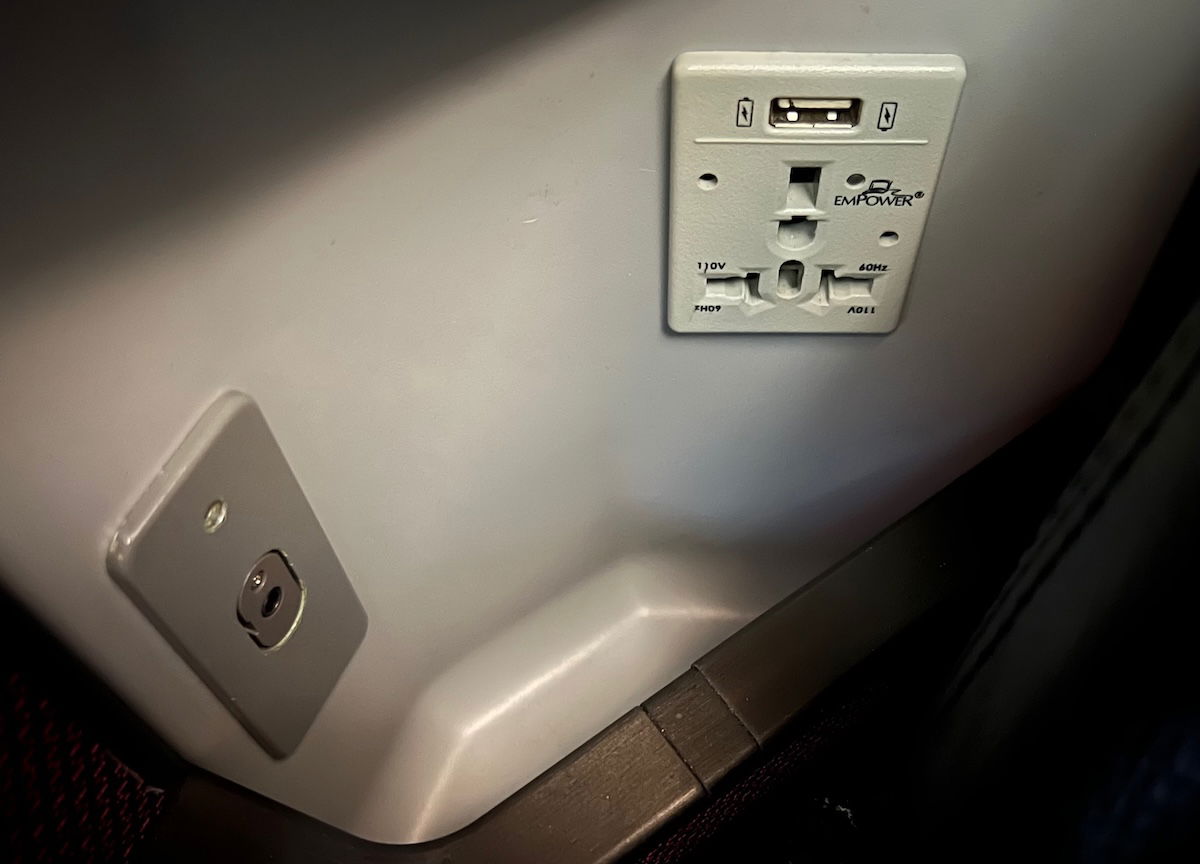
The seat back has a 15.6″ high definition display, with audio and video on demand.
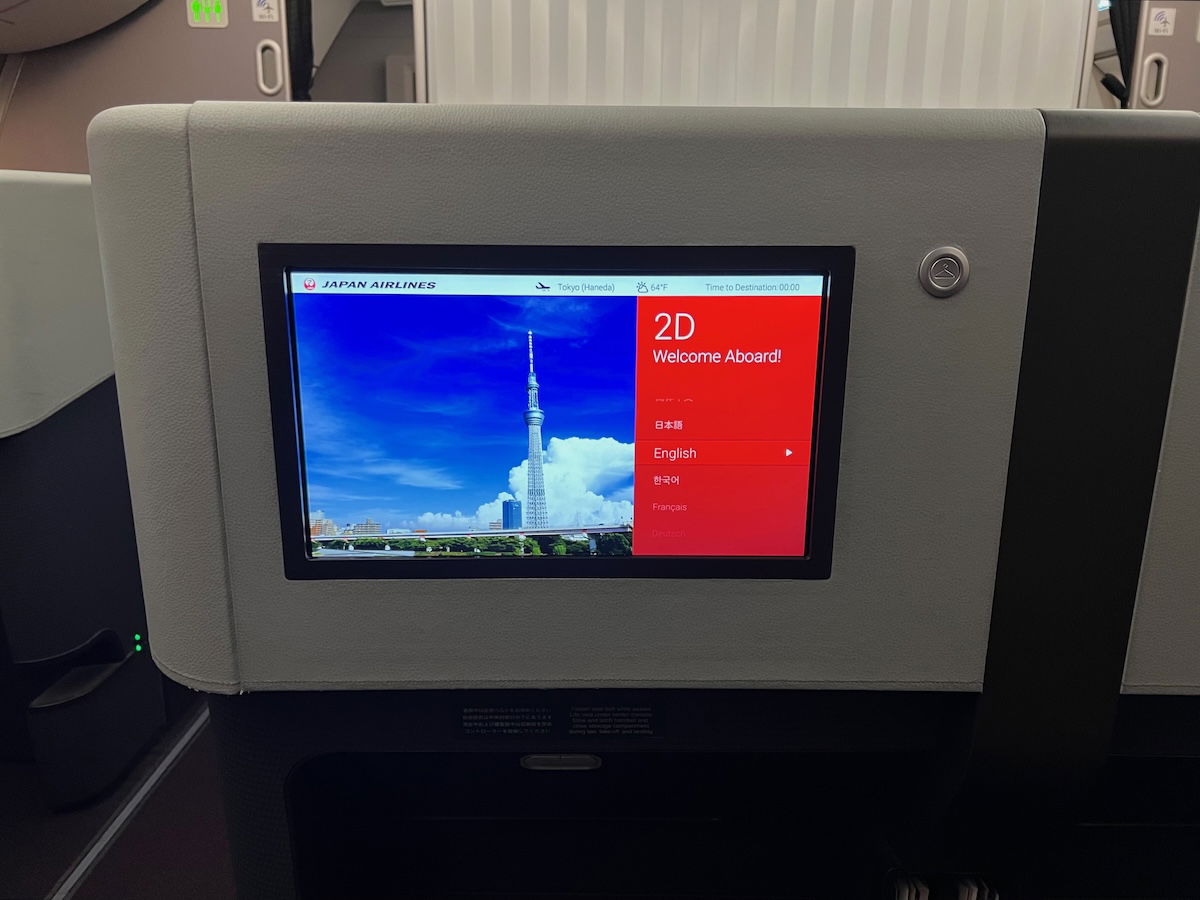
Since the seat has a hard shell, you’re not impacted if the person in front of you reclines. The seat back even has an enclosed storage compartment that can be opened or closed.
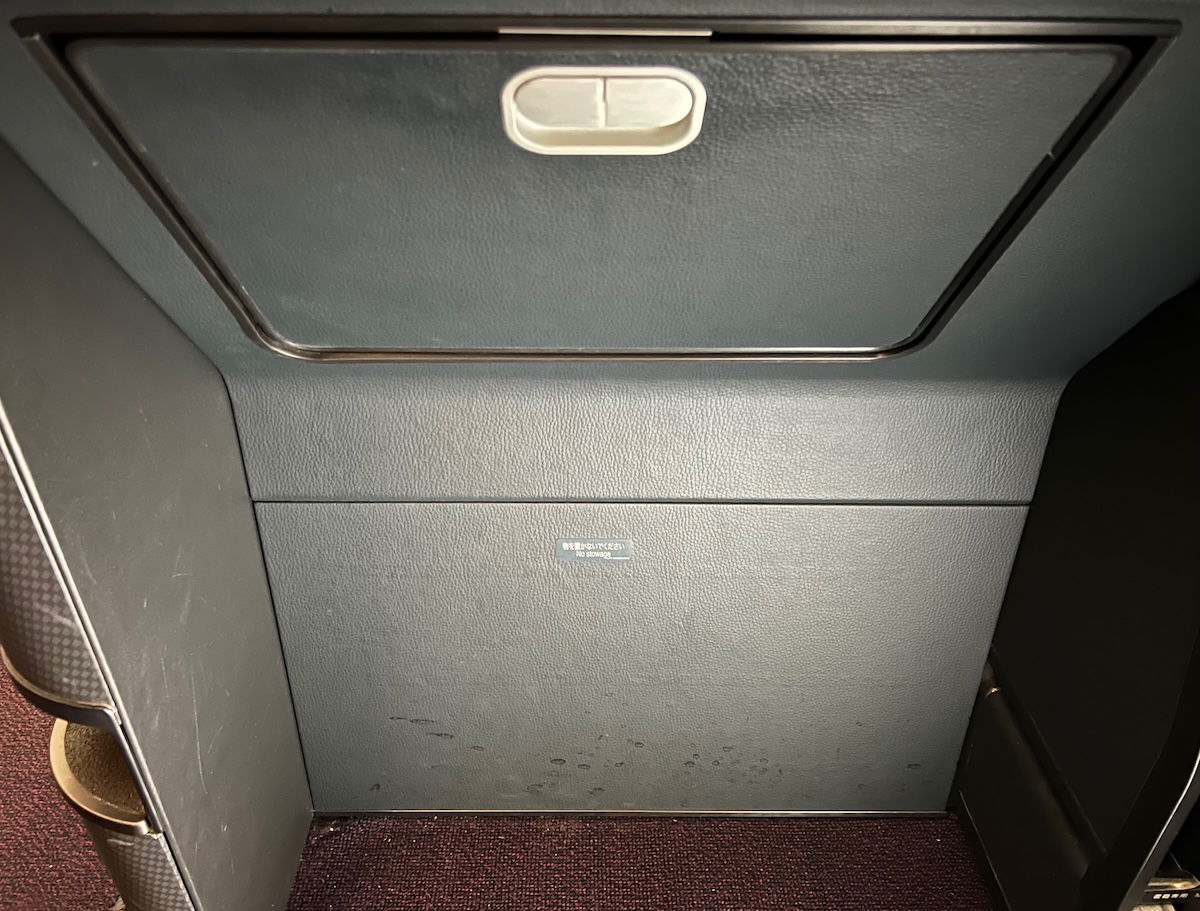

Lastly, for those curious, I also snapped a picture of “Class J” on this aircraft. There are 94 of these seats in a 2-4-2 configuration, and they’re comparable to premium economy on long haul flights. Think of this more as economy with a very spacious seat, rather than business class, given that the service in Class J is similar to economy, and it doesn’t offer lounge access or priority boarding.
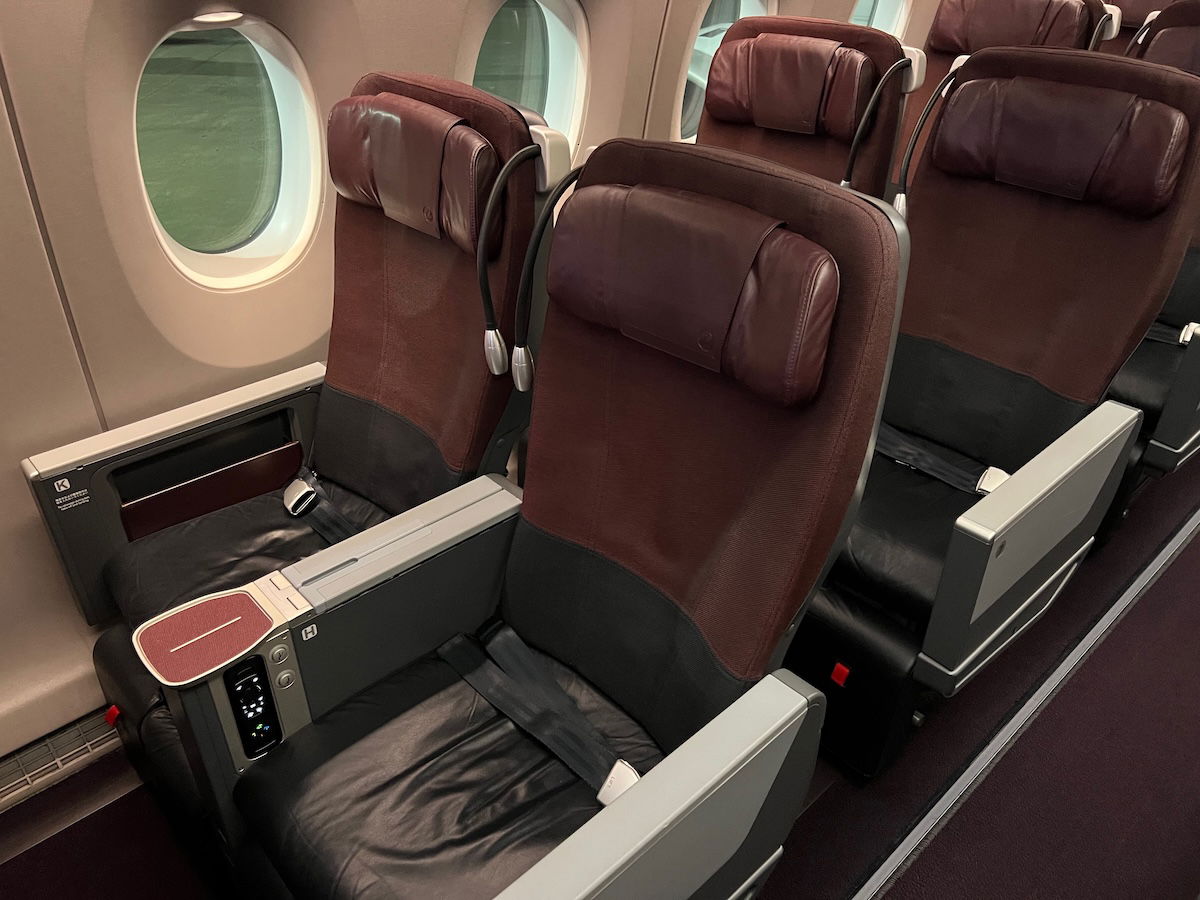
All-in-all, I loved Japan Airlines’ A350 domestic first class seat. Of course it can’t compete with long haul premium cabin seats, but this is the world’s only A350 configuration designed specifically for ultra-short flights. I also love how intimate the cabin feels — while these A350s are among Japan Airlines’ most dense aircraft, you wouldn’t know it based on the first class cabin.
Japan Airlines domestic first class amenities
Despite this being a short flight, there were a fair number of amenities. First up, there were noise canceling headphones, which were decent quality.
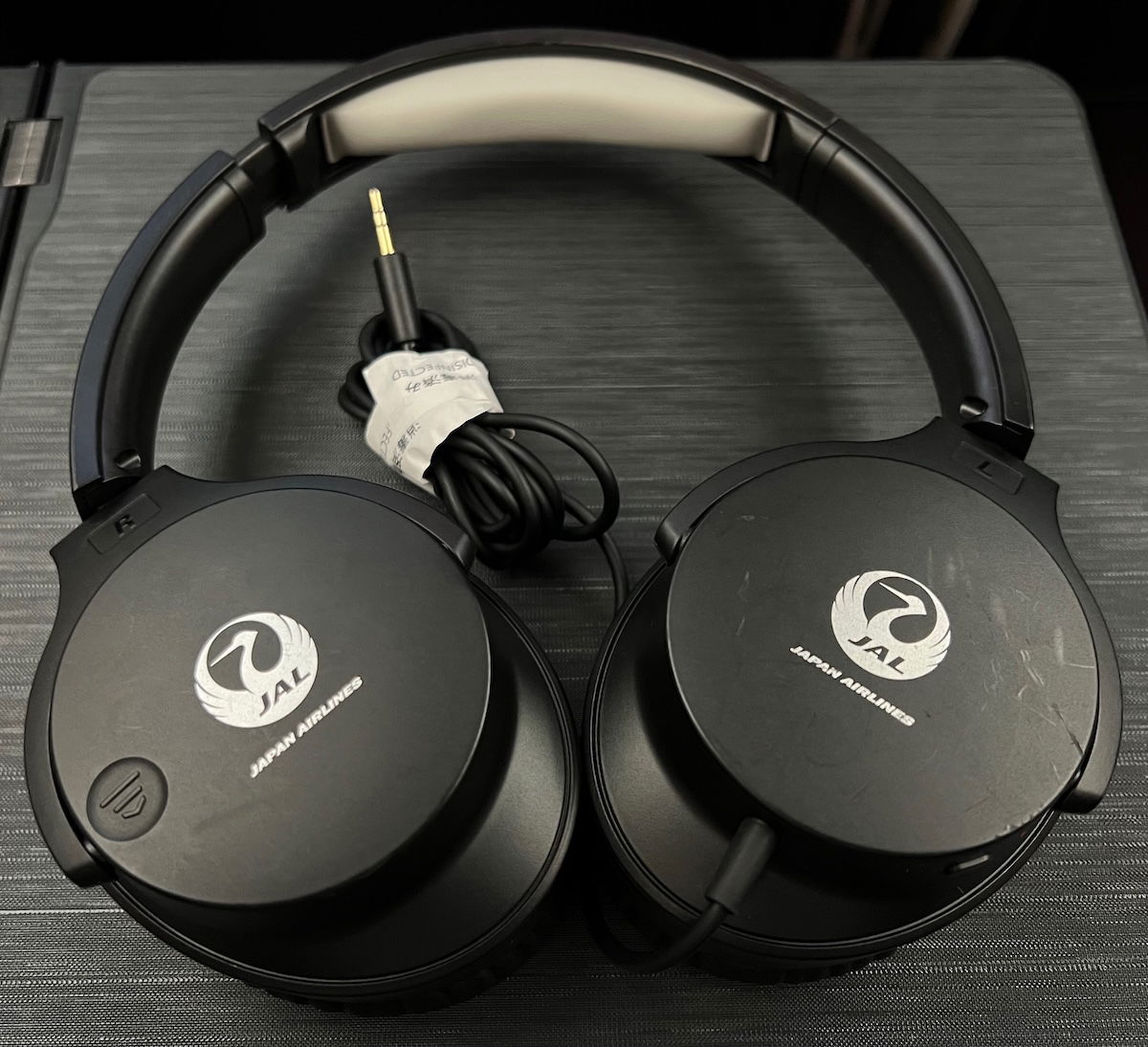
There were also slippers and a shoe horn. You’ve gotta love how slippers are so common in Japan (including on planes), while some airlines can’t even offer slippers in business class on long haul flights.

The menu for the flight was also placed at seats upon boarding.

Also waiting at each seat was a pillow, which wasn’t substantial at all. Think of it more as something for a little bit of extra back support. It looked almost like a laptop sleeve, or something.
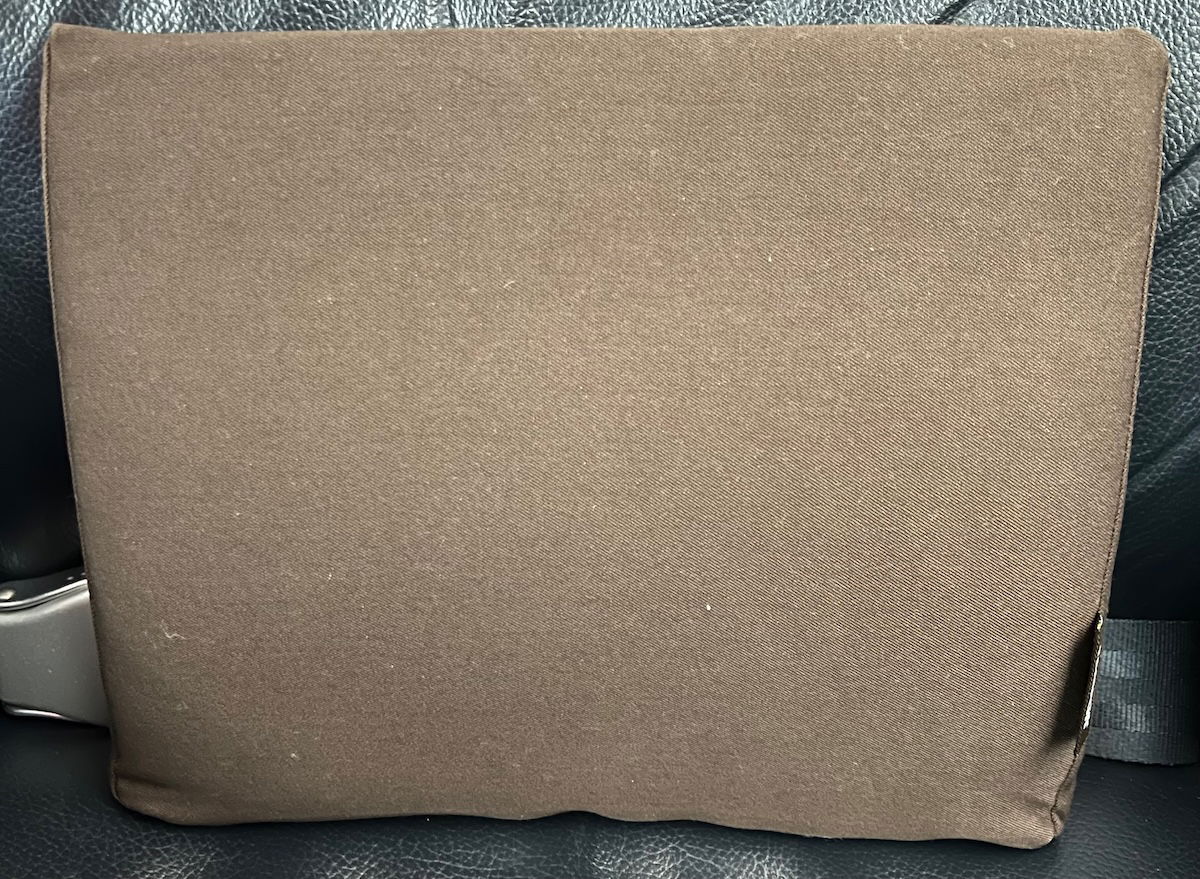
Blankets were also available on demand, and were more substantial than the pillows.
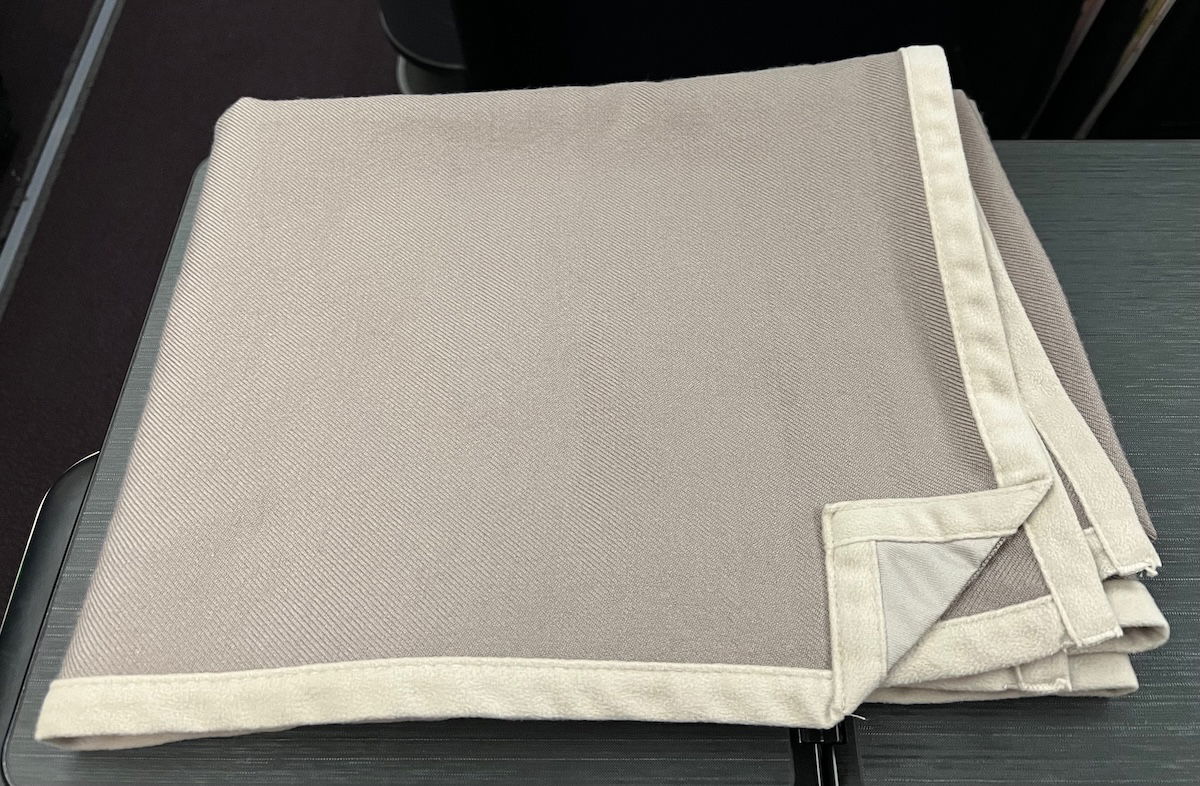
While there were no pre-departure drinks (totally understandable, given the focus on efficiency, when you board 350+ people in 15 minutes), packaged towels were offered, and they even had JAL first class branding.
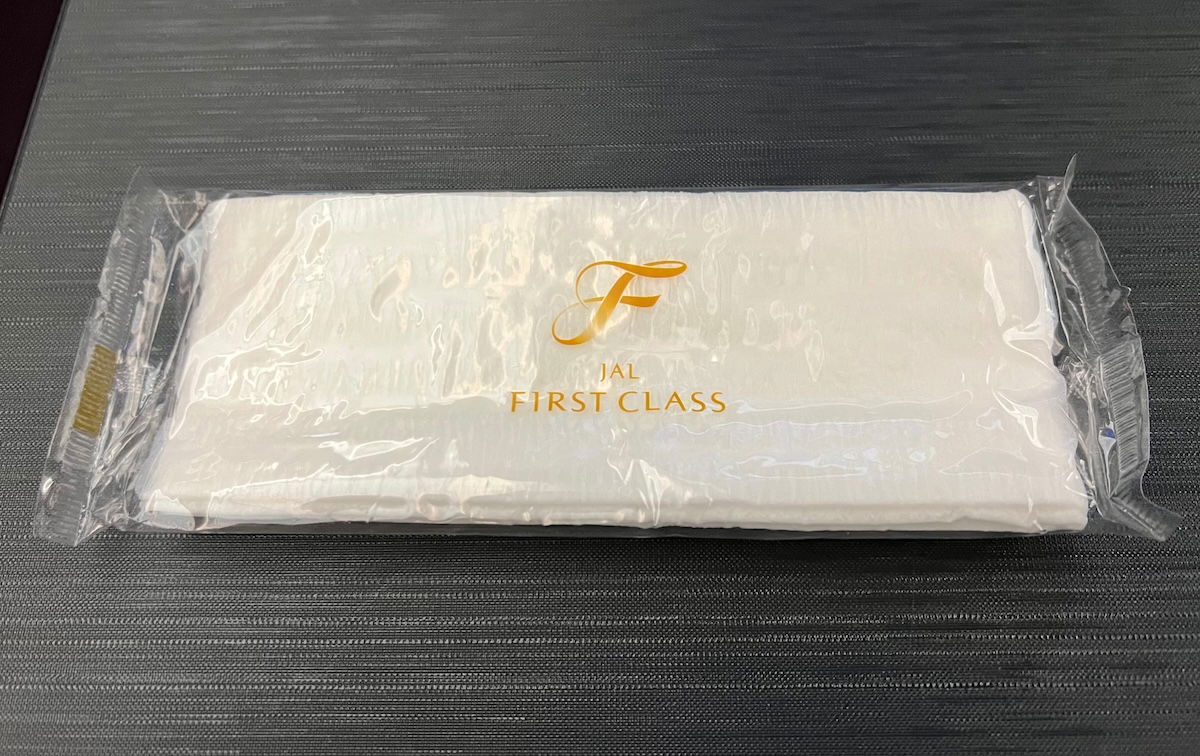
Japan Airlines A350-900 first class entertainment & Wi-Fi
Japan Airlines’ domestic A350s have a different entertainment system than you’ll find on many long haul jets, but it’s still quite good. There are a variety of movies, TV shows, audio, and of course the map feature. There were around 25 movies and around 100 TV shows in the library, so it’s not a huge selection, but it should be easy enough to stay entertained for a short flight.
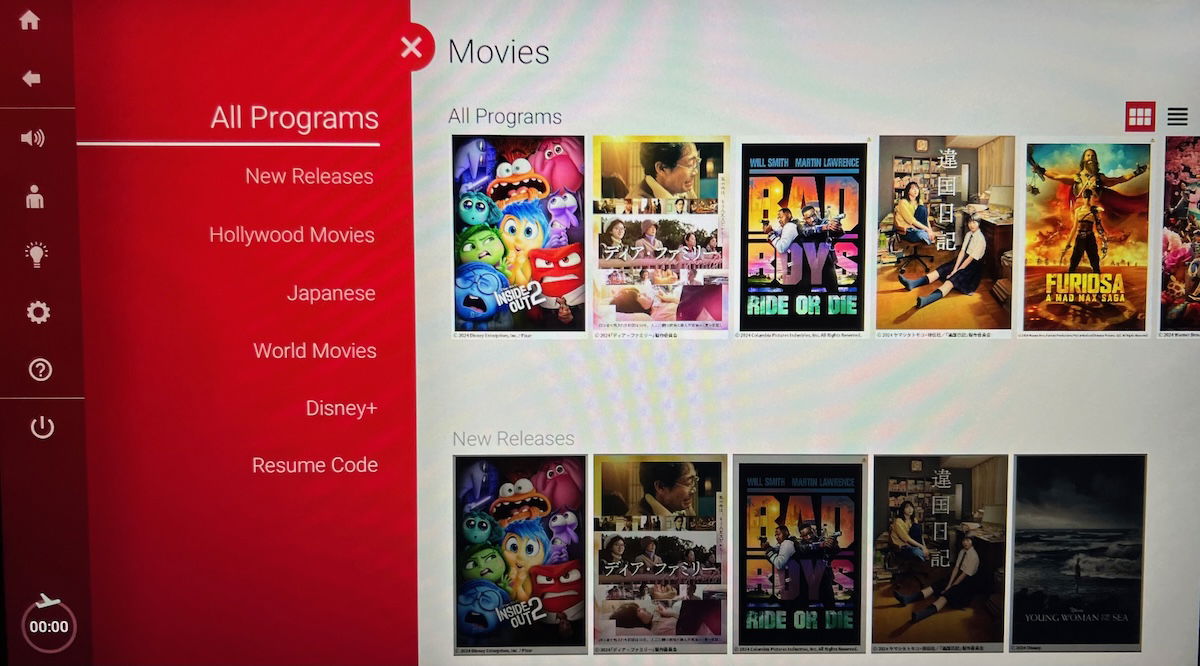
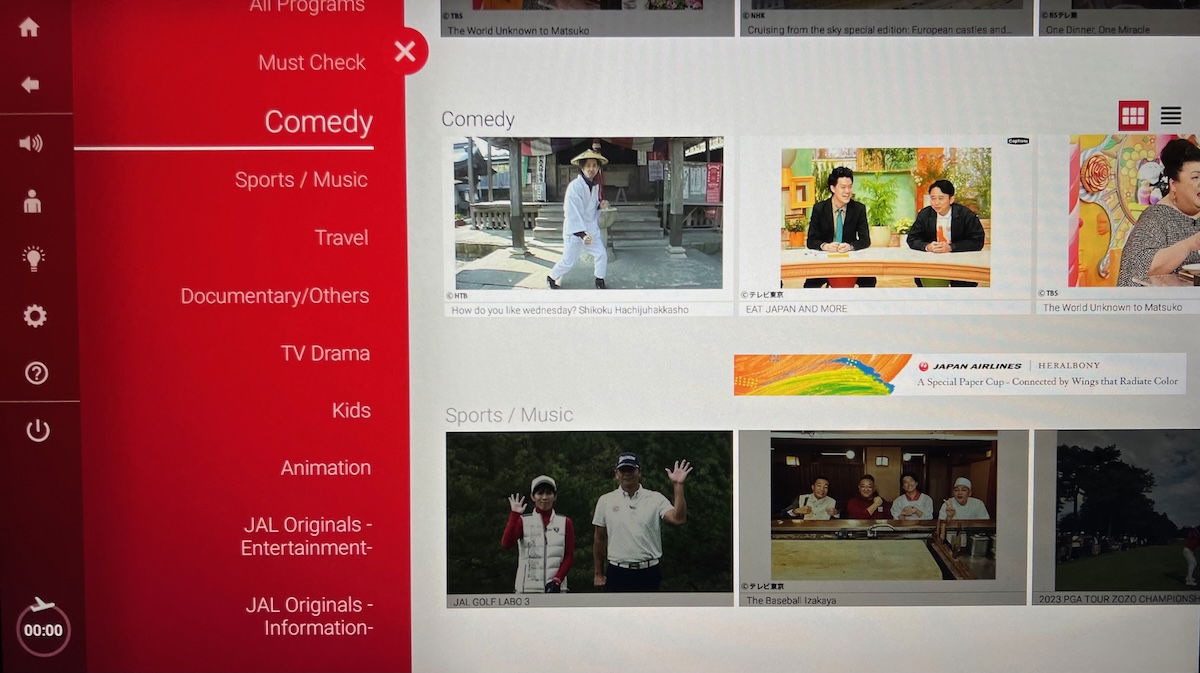
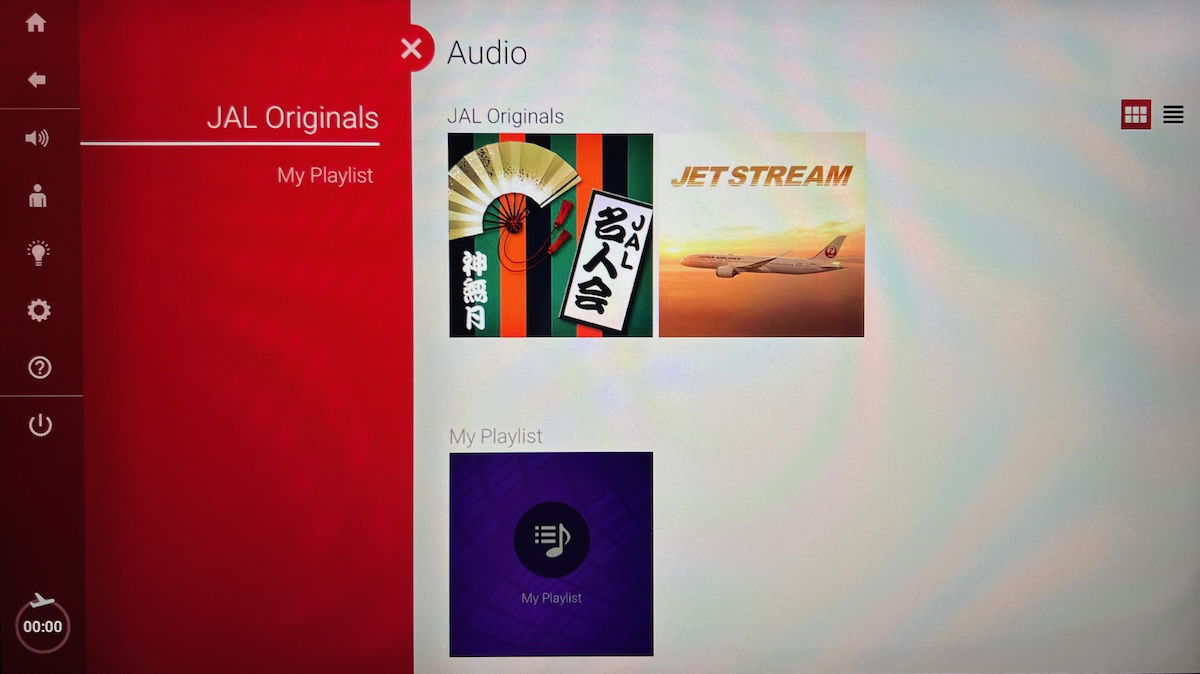
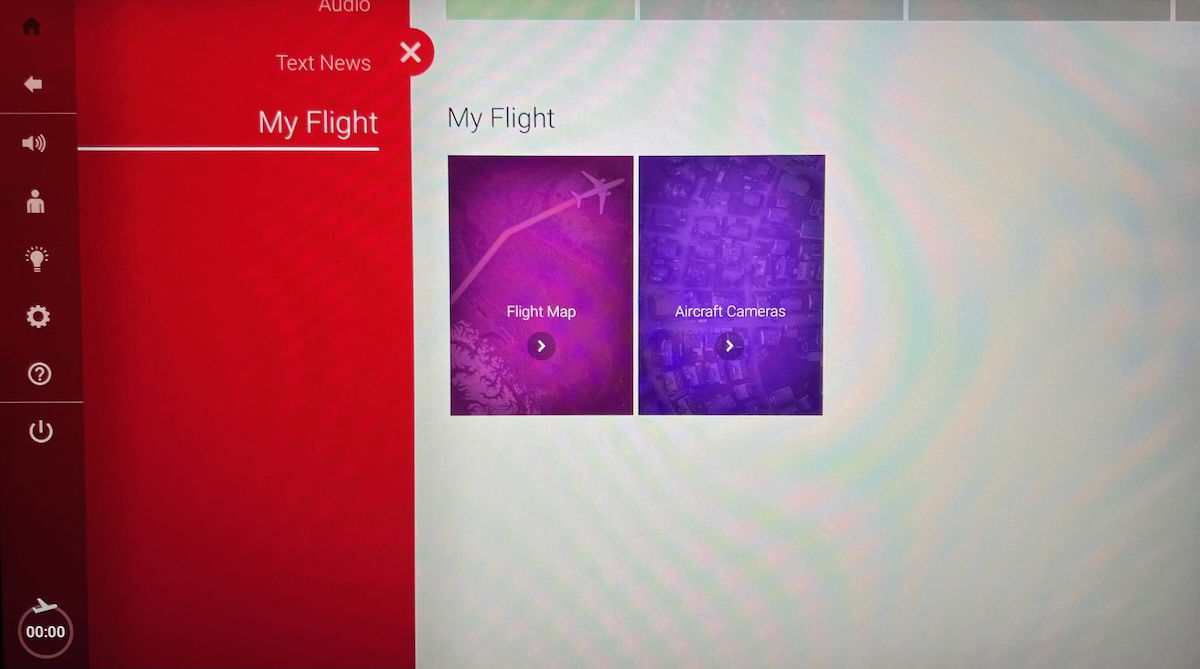
My favorite part of the entertainment system was the tail camera, which is something that I love about the A350 (for the airlines that choose to offer it).
Japan Airlines even offers free Panasonic Wi-Fi on its domestic A350s, so all passengers can connect with just one click. I found the Wi-Fi speeds to be excellent, and it’s nice to be able to connect all your devices so easily, with no data caps.
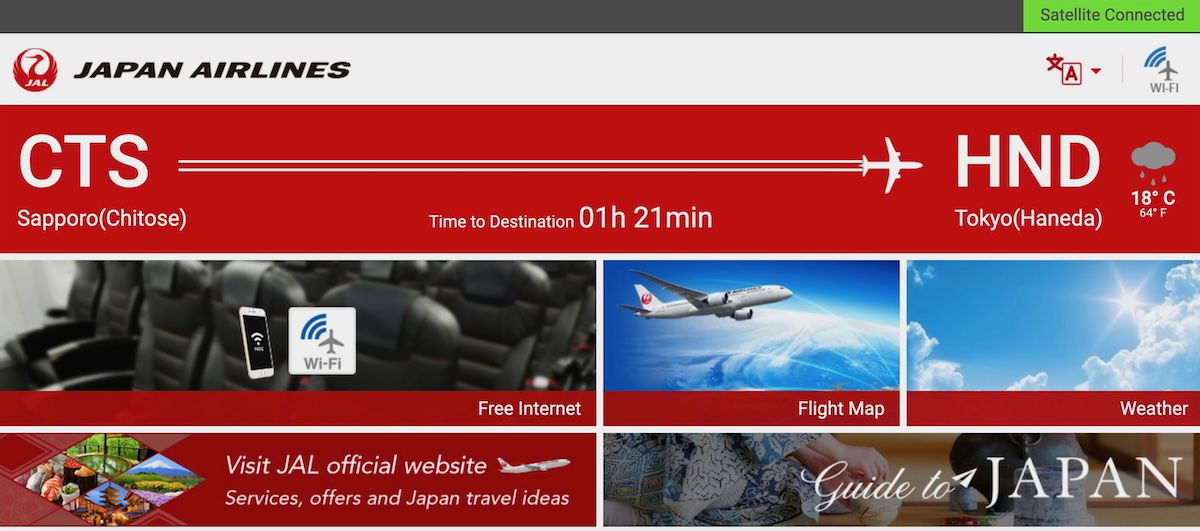

Between a modest movie and TV selection, the map, the tail camera, and free Wi-Fi, you shouldn’t be bored on Japan Airlines’ A350.
Japan Airlines A350-900 departure from Sapporo
Boarding was efficient, with the plane being totally full, including all first class seats being occupied. We only ended up finishing boarding by 8:10PM, five minutes after our scheduled departure. There seemed to be some issue that delayed the end of boarding, and I’m not sure what it was. So since this is Japan, of course there was a PA apologizing for the delayed departure due to cabin preparations.
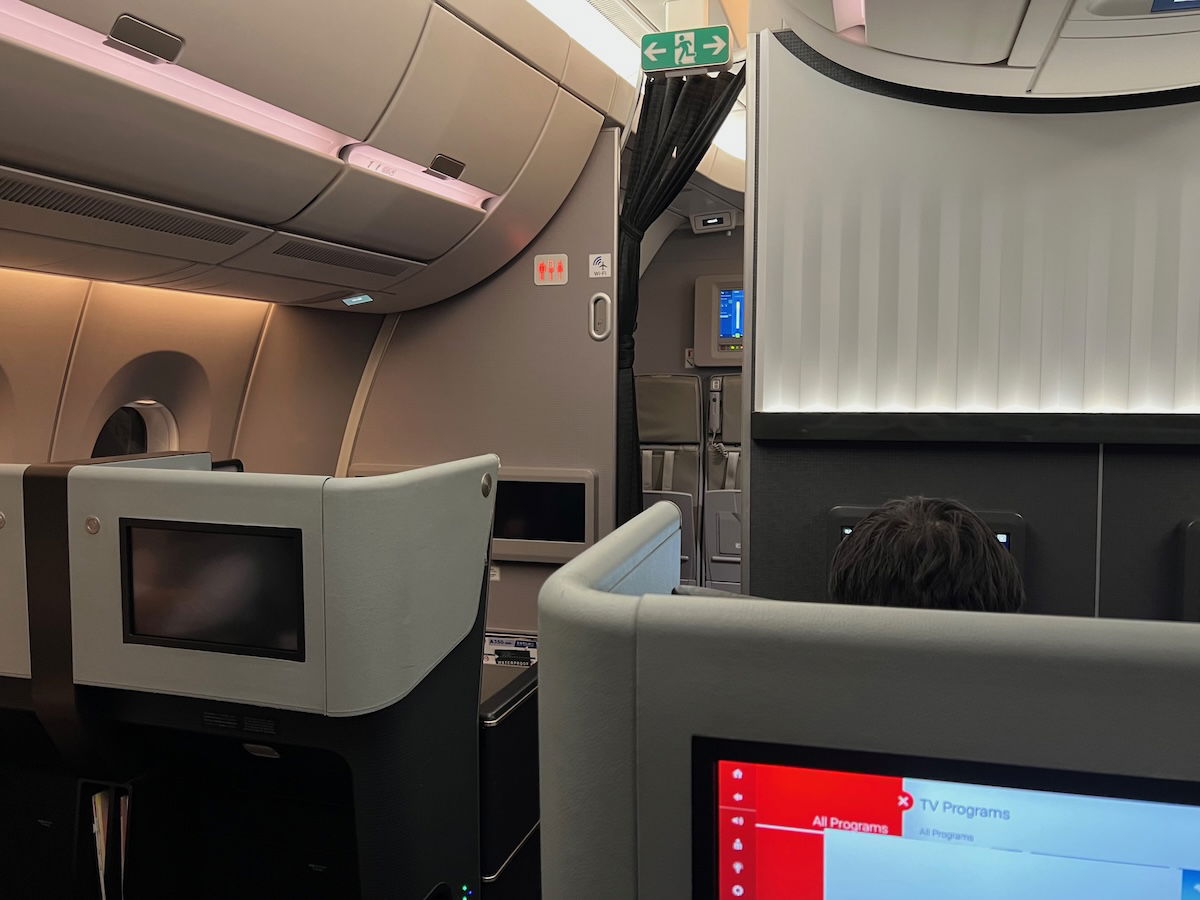
The main cabin door closed at 8:10PM, and at 8:15PM we began our pushback, and at that point the safety video was screened. Our departure was super quick — we started our taxi at 8:20PM, and by 8:25PM we were barreling down runway 1L.
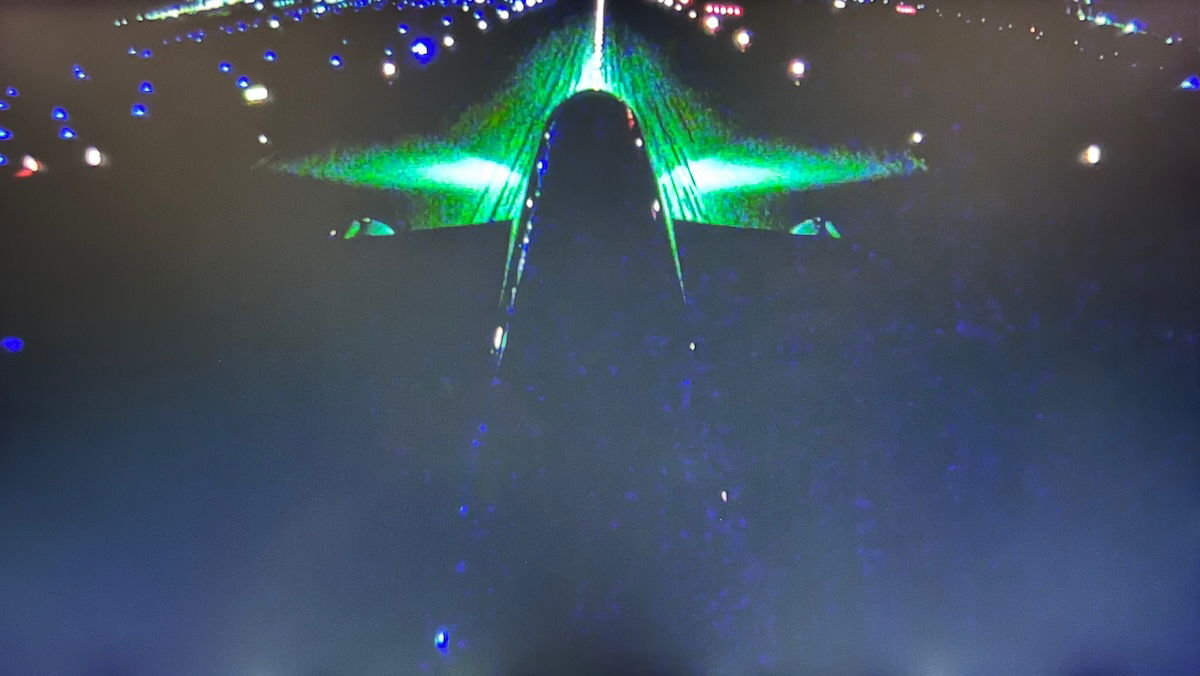
Japan Airlines first class meal service
The seatbelt sign was turned off around five minutes after takeoff, and at that point the crew sprung into action. Japan Airlines offers a full dinner service in first class, and you can find the menu and drink list below.

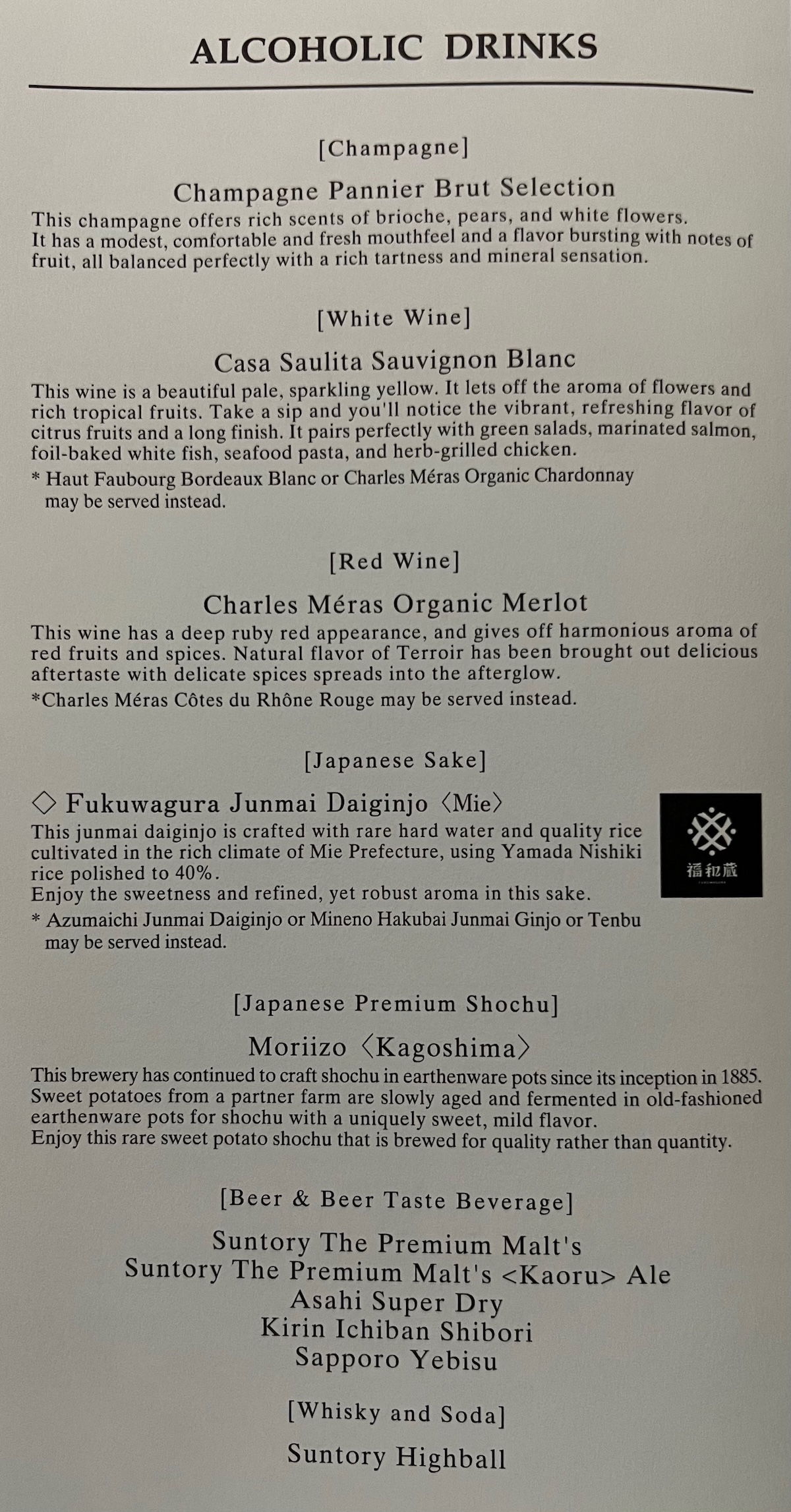
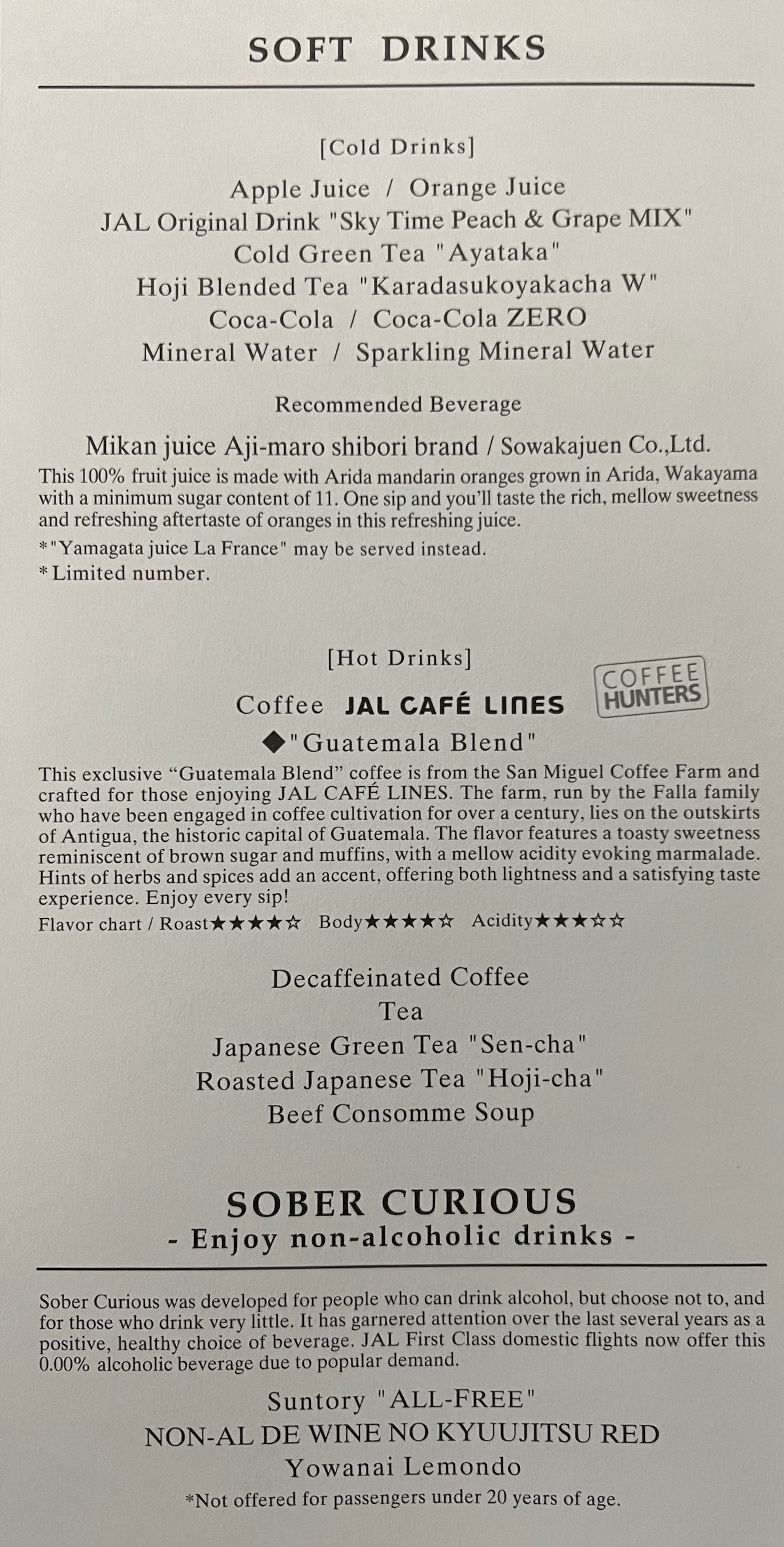
There’s no choice of meals, but instead, each passenger is served the same thing. Dinner was comprised of appetizers of barley and seafood salad as well as vegetable salad, a main course of Kagoshima Kurobuta Pork Saltimbocca, and a dessert of coffee panna cotta. The meal was also served with a bread roll and butter.
I don’t eat pork, so the meal wasn’t ideal for me, and I probably wasn’t lucky in terms of when I flew this product, since the options rotate. Also, since I upgraded on the day of departure, it’s not like I could have ordered a special meal. Still, I enjoyed the appetizers and dessert.
To drink, I had a glass of champagne — on domestic flights, the airline serves Champagne Pannier Brut Selection.
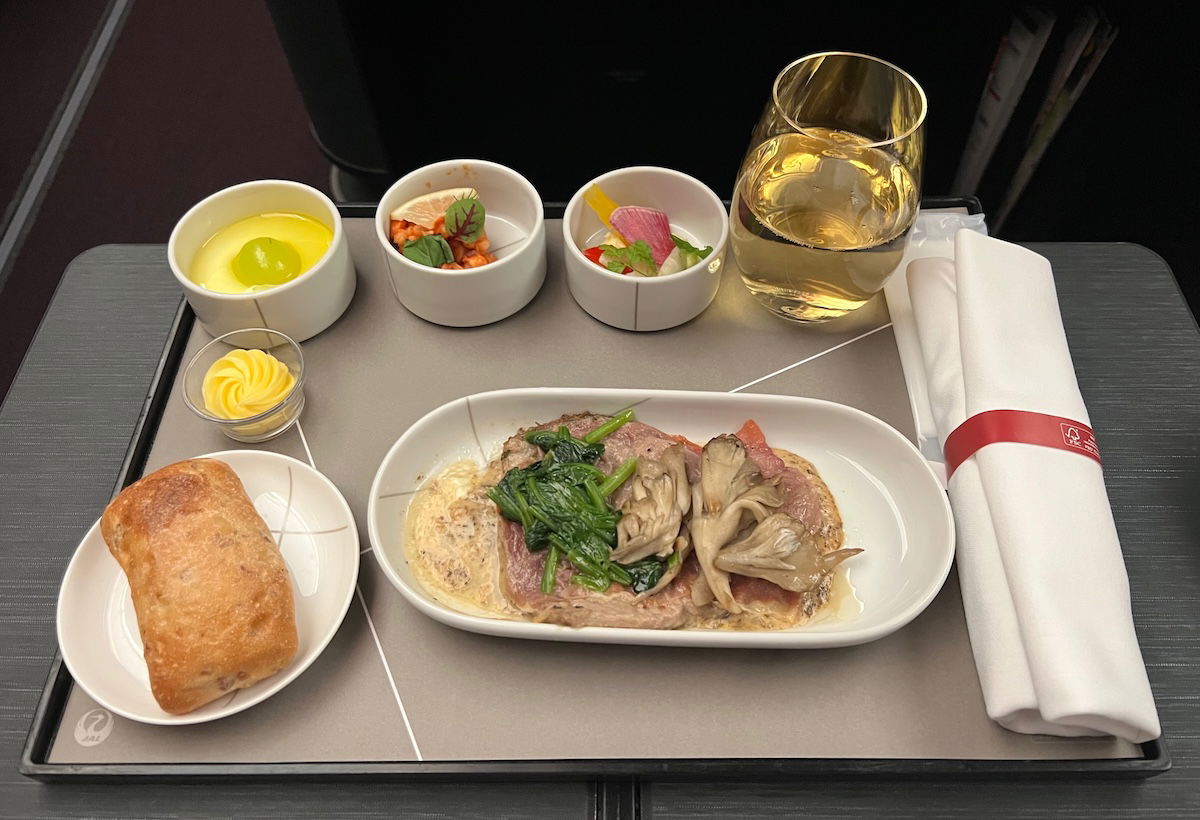
The flight attendant saw that I didn’t eat much of the meal, so after clearing my tray, she brought me a plate with some packaged snacks, including fermented soybeans and rice crackers.
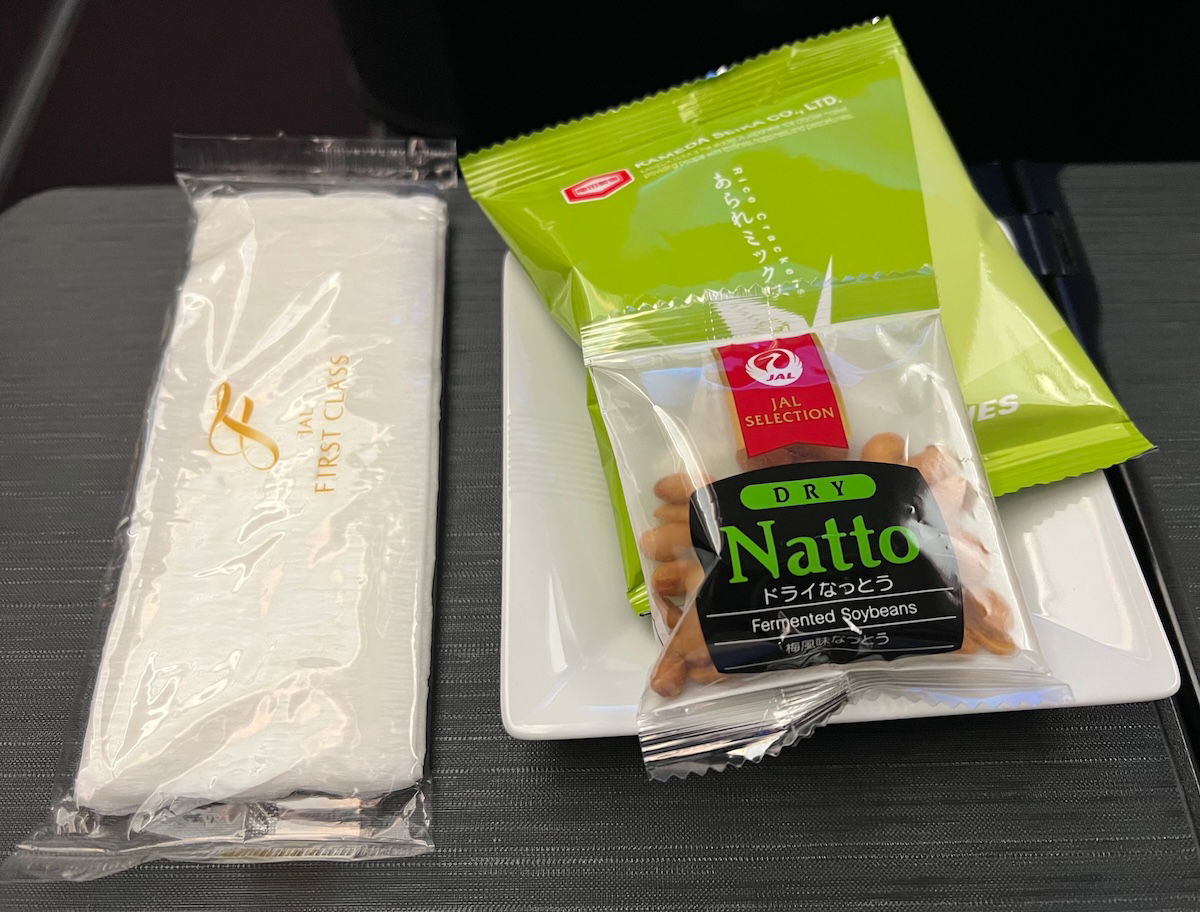
After the glass of champagne, I decided to have some sake to drink, which was served with even more snacks.
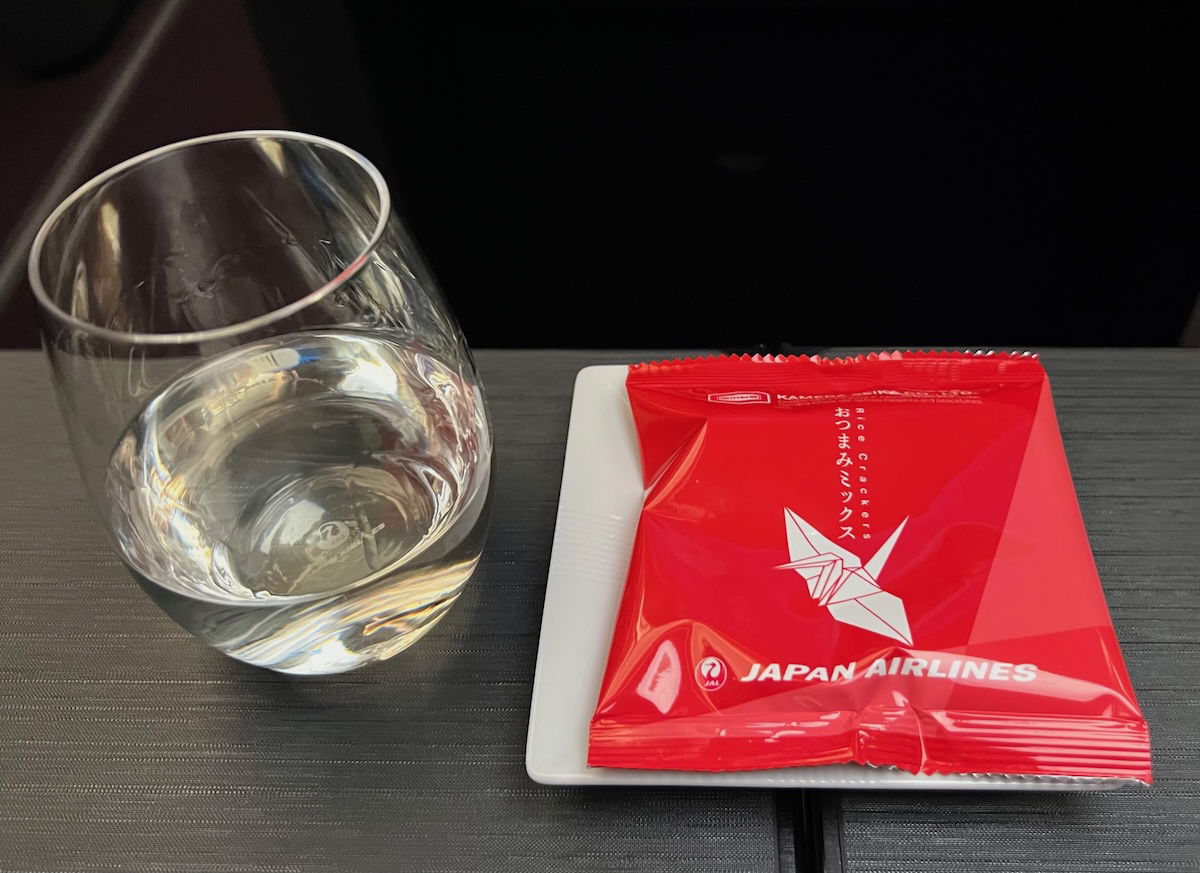
Japan Airlines A350-900 first class lavatory
Japan Airlines’ domestic A350s have one dedicated first class lavatory, located at the front left of the cabin. The lavatory isn’t huge, but was spotless, down to the toilet paper being folded into perfect triangles. Ah, the joy of flying with a Japanese airline.
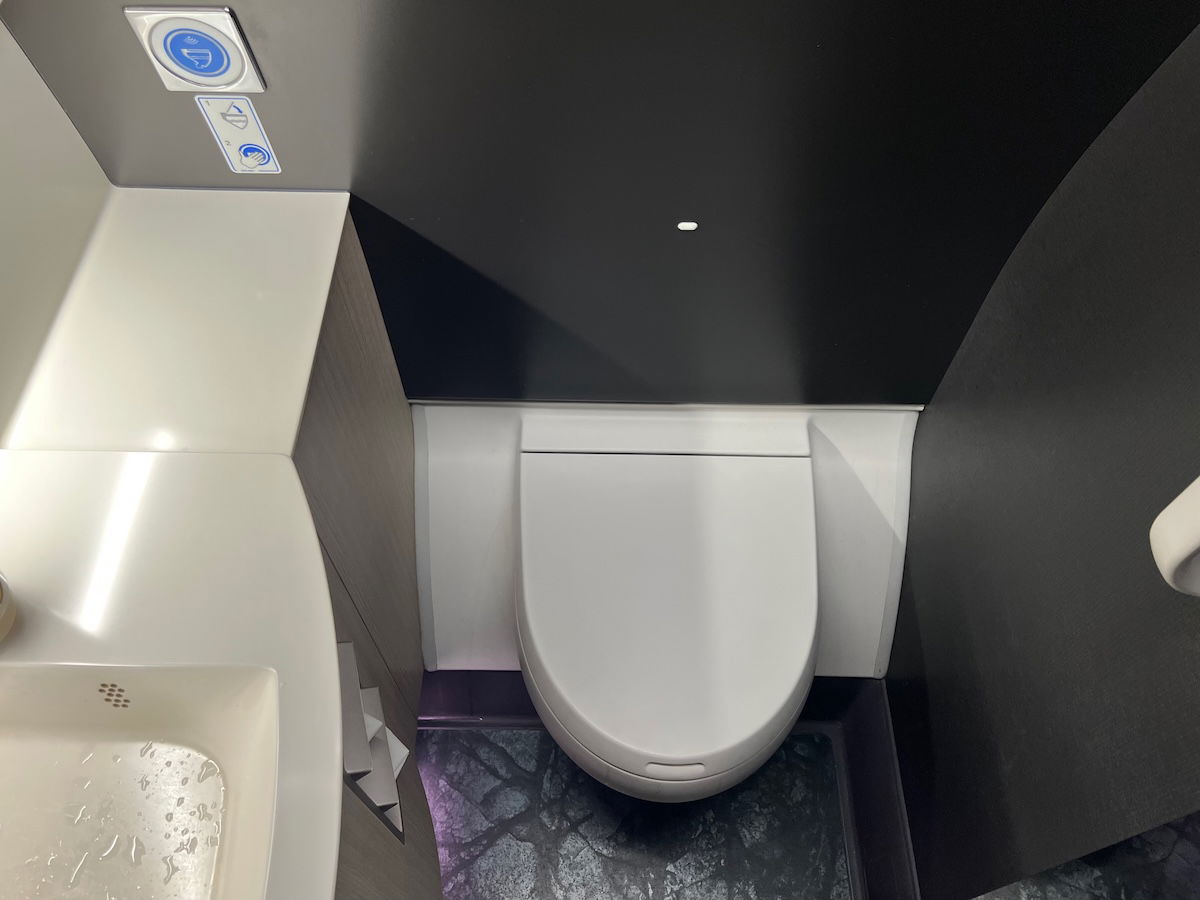
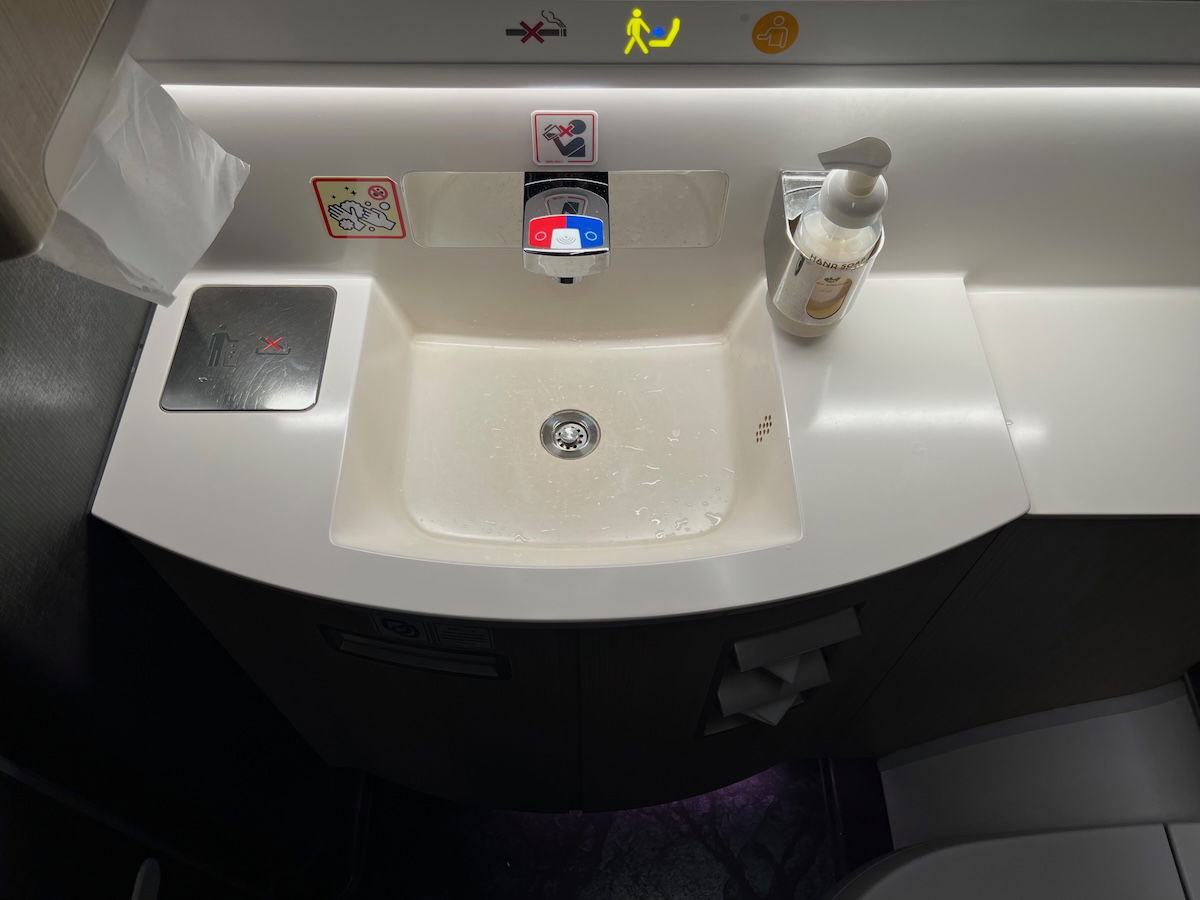
Japan Airlines first class service
Perhaps what made this flight the loveliest is how friendly the crew was, and how personalized the service was. Again, domestic first class within Japan often costs a couple of hundred bucks, so it’s not the most expensive product out there. Despite that, you’re treated extremely well.
During boarding, the chief cabin attendant, Arai, came by to introduce herself to each first class passenger. There were then two flight attendants working first class (one on each side), and working my aisle was Kikuchi. She also introduced herself to each passenger in her section during boarding.
Service was simply flawless, in terms of friendliness, attention to detail, and attentiveness. For example, the cabin had to be prepared for landing a bit earlier than usual, due to anticipated turbulence. So after the flight attendant collected my partly consumed glass of sake, she returned a moment later with a plastic cup, encouraging me to finish the sake at my leisure (and topping off the cup as well).
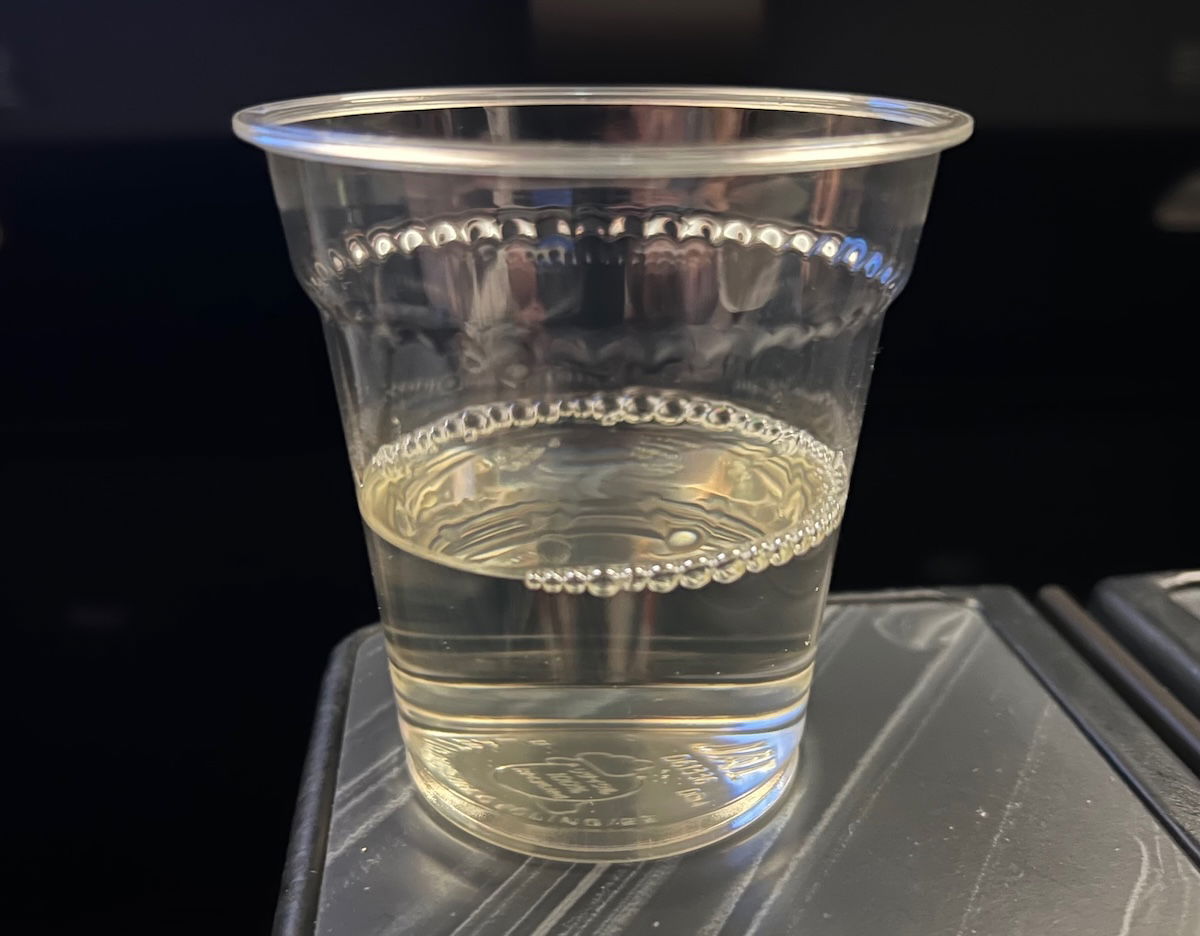
Japan Airlines A350-900 arrival in Tokyo
20 minutes after takeoff, the captain had announced that we were at 34,000 feet, and would be landing around 9:55PM. We had started our slow descent pretty early, around 9:15PM. A few minutes after that, the crew had to be seated.
There was indeed chop on the approach, as it was a stormy evening in the Tokyo area. It was quite an adventure to watch the tail camera.
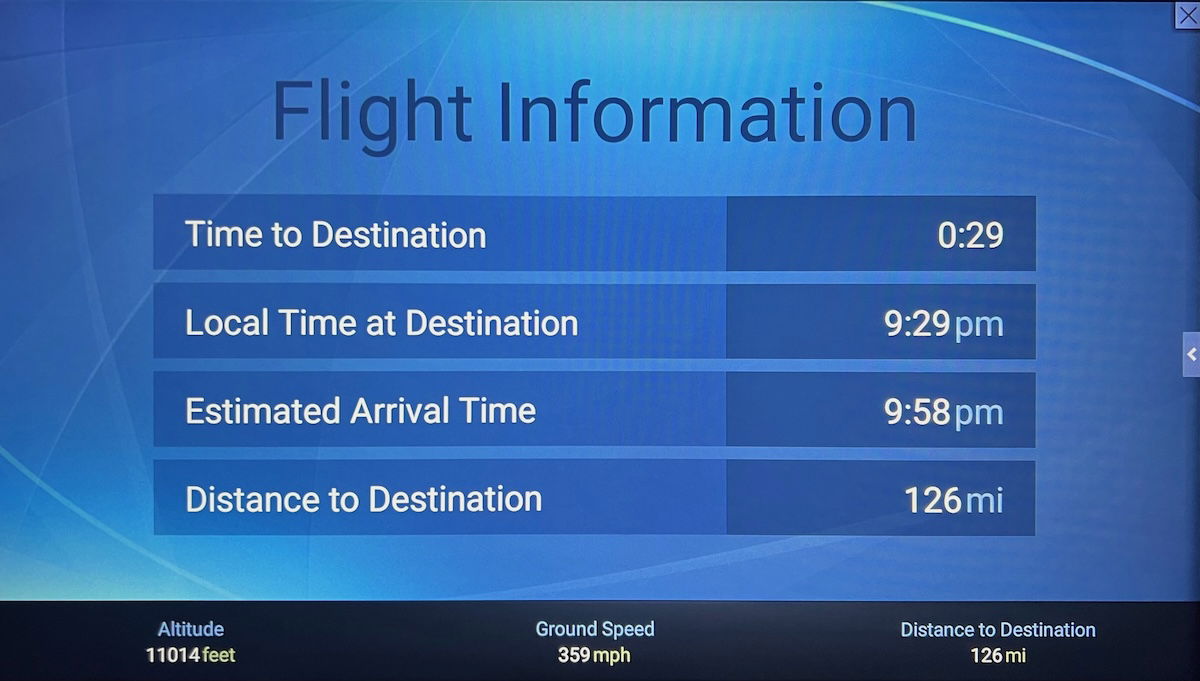
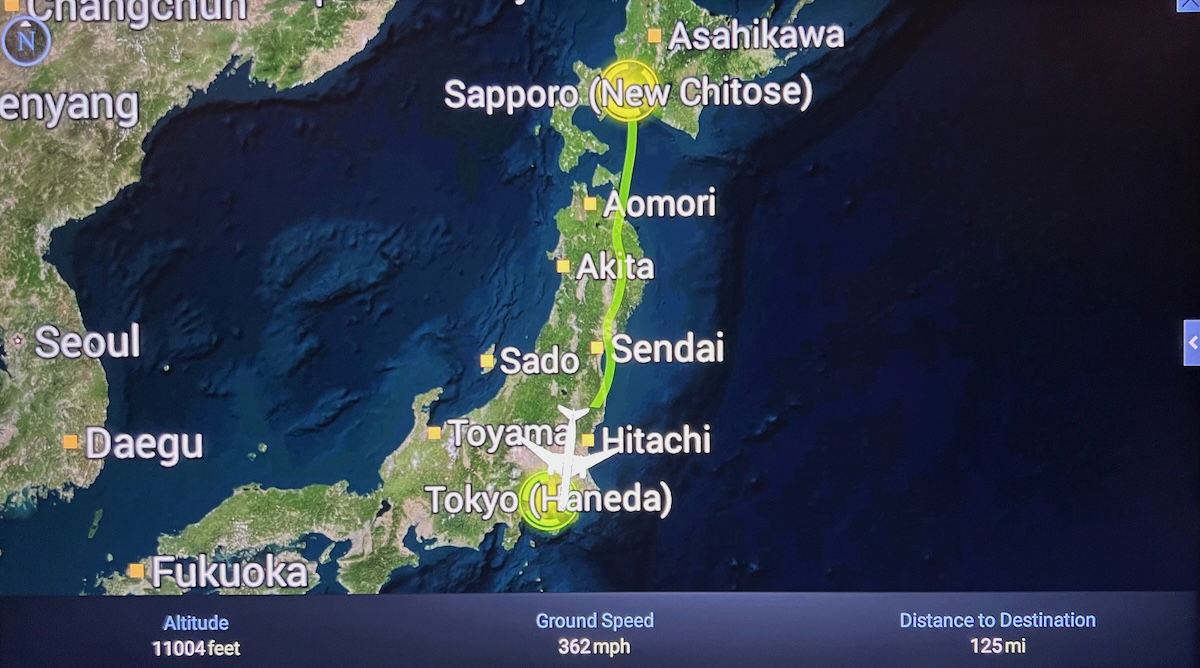
Eventually we initiated our final descent into Tokyo, and we had a firm touchdown at 9:55PM.
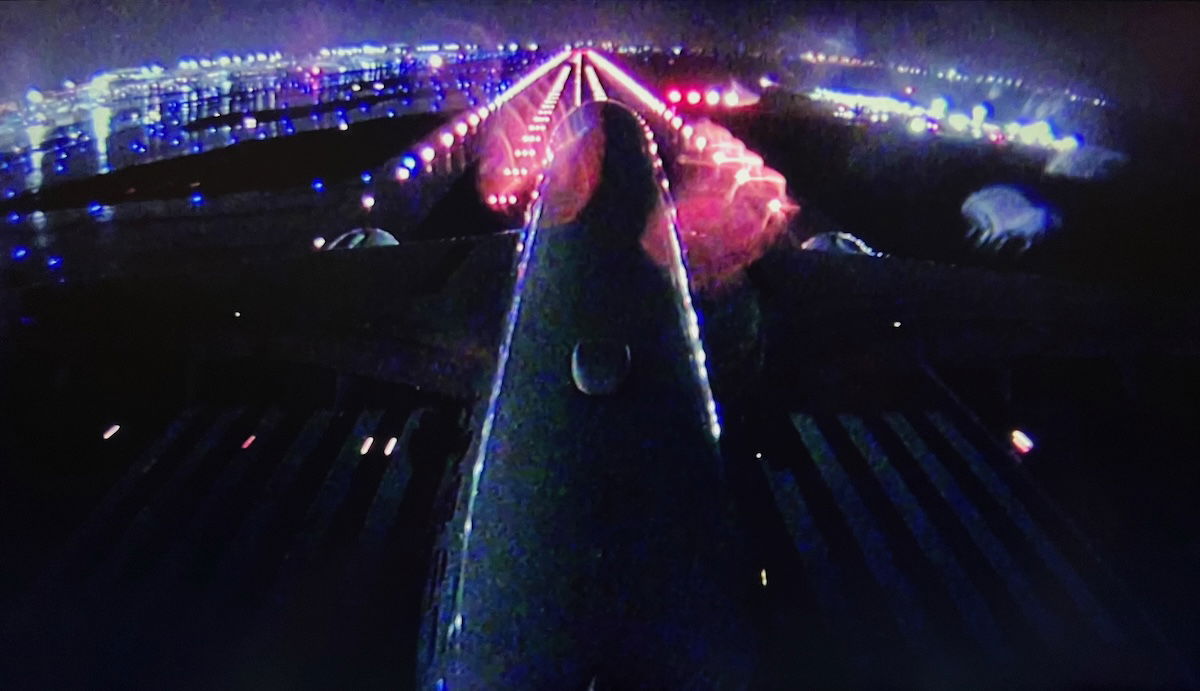
From there we had a roughly 10-minute taxi to our arrival gate, where we pulled in at 10:05PM, around 20 minutes behind schedule.
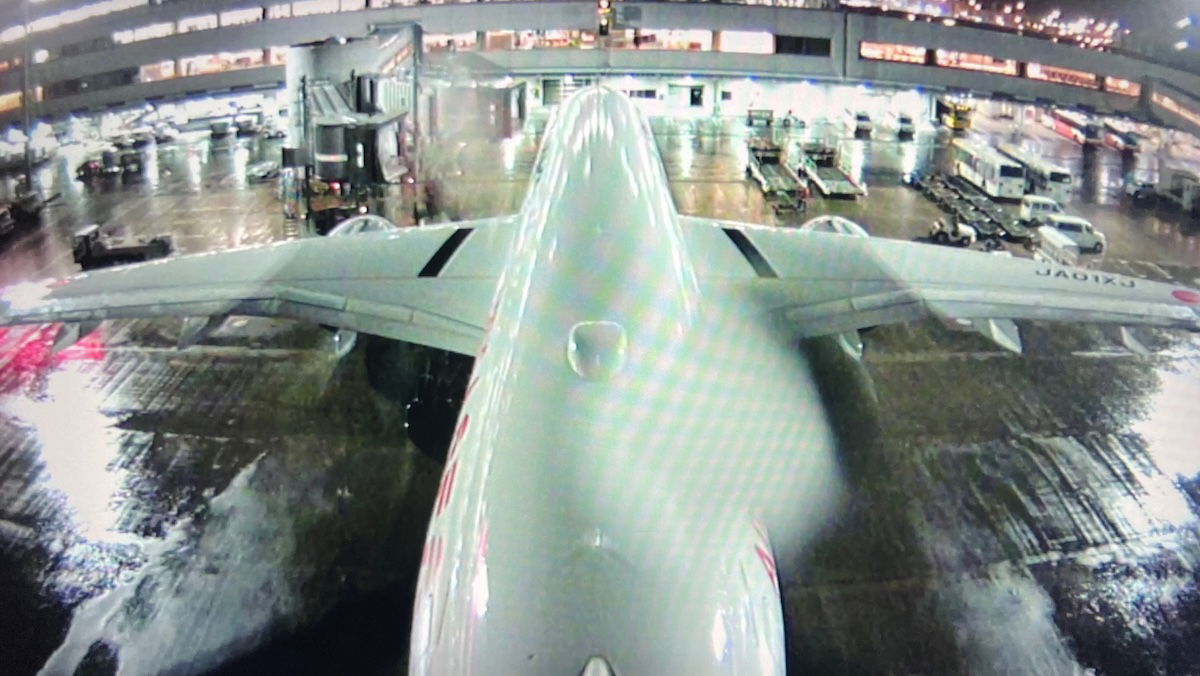
From there I headed to the First Cabin Haneda Terminal 1 (an in-terminal capsule hotel), where I’d be spending the night, prior to continuing to New York the following morning in Japan Airlines’ A350-1000 business class.
Bottom line
Japan Airlines’ domestic Airbus A350-900 first class is absolutely delightful, and might be one of the best value premium experiences out there, given the reasonable pricing. These A350-900s boast super comfortable seats, there’s free Wi-Fi and extensive entertainment (including a tail camera), there’s a full meal service and solid drink selection, and service couldn’t be friendlier.
Just about everywhere else in the world, the concept of an A350 designed specifically for short haul flights would be basically unheard of, but that’s how it works in Japan, given the high demand domestic markets that exist. If you have the chance to fly Japan Airlines’ domestic first class, I can’t recommend it enough.
What’s your take on Japan Airlines’ domestic first class product?

















This looks amazing, much better than anything within North America. It's too bad you don't eat pork - Kurobuta pork is really, really good pork, better than Iberico even.
The highlight for me was the 'sober curious' heading of the non alcoholic drinks section of the drinks list.
Does it address people who are curious about being sober? lol!
@Glenn T, yes. It does address those curious about being sober, or who are sober. Not drinking doesn’t always have to mean drinking just pop, water, juice, coffee, or tea anymore. There are getting to be a huge variety of mocktails and NA beers out there. As an alcoholic who has recovered, I appreciate having beverage options that are a little unique whether I’m on the ground or in the air.
The seat had more scratches than what I would expect from a Japanese airline. To be fair, it's flying way more flights a day than usual... so the maintenance might be tricky.
DELTA is better!
In what way? Profits to the airline?
Delta’s domestic service is pitiful—and I have flown nearly 2.5 million miles and am currently a Diamond Medallion on that airline. If there was a product like JAL domestic first class within the U.S., I would fly it all the time.
Delta needs to send their flight leaders and senior ticket agents to Japan to study how JAL trains and their staff performs those duties. That...
In what way? Profits to the airline?
Delta’s domestic service is pitiful—and I have flown nearly 2.5 million miles and am currently a Diamond Medallion on that airline. If there was a product like JAL domestic first class within the U.S., I would fly it all the time.
Delta needs to send their flight leaders and senior ticket agents to Japan to study how JAL trains and their staff performs those duties. That level of attention to detail and service is sorely needed at Delta (the airline who dreams of being a bank).
That's just a troll. For the REAL Tim Dunn look for "Diamond" after his name, not "Guest". Do not engage Guest postings under his perceived name to hopefully eliminate these "jokesters" one day.
Couldn’t agree more, it’s tiresome and typically not terribly original.
Not as tiresome as the real Tim Dunn, to whom the no-engagement rule also applies.
Flying in First Class is a big part of my lifestyle—paid fares only, no points. For me, it’s all about the experience, and Japan Airlines consistently delivers the best. From the impeccable service to the exquisite in-flight dining, every detail feels curated for true luxury. Their attention to comfort and hospitality sets them apart from every other airline I’ve flown.
Same here, fly First class all the time. Always paid and wouldn’t be caught dead paying anything other than full fare. Points and miles mean nothing to me. In fact, I don’t even have an FF account - just let the points evaporate into the ether.
@FFlyer HaHa!! A well-said comment for Endre.
A real 2018 throwback… haven’t seen the Gets On The Miles & Points Blog To Brag About Flying F But Never Using Points guy in what feels like years, but it used to be seemingly a daily occurrence way back when
Lol is Endre back? He used to only fly first class. I thought he was banned
Will Endre go the way of the dinosaurs too as First class cabins everywhere careens down that path?
no points, but I read and comment on a points blog...the irony!
A few thoughts on this: JAL F is very good and solidly outdoes ANA's Premium Class on competing routes, both in terms of ground and inflight experience (especially as their A350s are much nicer than ANA's very old domestic 767/777/787s)
However, JAL's domestic F footprint is much smaller. ANA offers Premium Class with a full drink/meal service on many more routes, including narrowbodies, which JAL does not.
JAL F also has fewer total seats than...
A few thoughts on this: JAL F is very good and solidly outdoes ANA's Premium Class on competing routes, both in terms of ground and inflight experience (especially as their A350s are much nicer than ANA's very old domestic 767/777/787s)
However, JAL's domestic F footprint is much smaller. ANA offers Premium Class with a full drink/meal service on many more routes, including narrowbodies, which JAL does not.
JAL F also has fewer total seats than ANA Premium Class, so JAL will sell out quite often, making upgrades an unreliable way to confirm an F seat.
Another note about the IFE, @Ben, it sounds like you didn't actually go in and watch much of it since the majority of the content is actually all Japanese dubbed/subbed, even if it's originally Western content, this makes it pretty difficult to consume any movies/shows inflight, for non-Japanese speakers. The free wifi does more than compensate for that though.
Agree with you on all points, though what I’m saying here applies to JAL generally and not the A350 in particular, Service- and product-wise, domestic or international, I agree JAL is quickly becoming the benchmark for all other airlines. Entertainment-wise, however, there’s a lot to catch up (no pun intended) especially with the MAGIC-VI system on other aircraft, which forces you to scroll endlessly on a tiny handset.
And the menu looks laughably simplistic, as...
Agree with you on all points, though what I’m saying here applies to JAL generally and not the A350 in particular, Service- and product-wise, domestic or international, I agree JAL is quickly becoming the benchmark for all other airlines. Entertainment-wise, however, there’s a lot to catch up (no pun intended) especially with the MAGIC-VI system on other aircraft, which forces you to scroll endlessly on a tiny handset.
And the menu looks laughably simplistic, as if someone trotted it out in Word using Times New Roman. Then again, Northeast Asian airlines (with the exception of the outstanding Cathay Pacific, which is highly Westernised) were never known for their typography and branding compared to Western or Gulf airlines.
In that sense, JAL is a bit like Muji: unbranded, understated luxury. And I fully mean that as a compliment for JAL. You don’t need to speak English as casually as KLM or even SQ to achieve excellence, which is what JP and TW airlines have mastered even with the language barrier:
Accidentally posted twice. Please disregard the other comment.
Agree with you on all points, though what I’m saying here applies to JAL generally and not the A350 in particular, Service- and product-wise, domestic or international, I agree JAL is quickly becoming the benchmark for all other airlines. Entertainment-wise, however, there’s a lot to catch up (no pun intended) especially with the MAGIC-VI system on other aircraft, which forces you to scroll endlessly on a tiny...
Accidentally posted twice. Please disregard the other comment.
Agree with you on all points, though what I’m saying here applies to JAL generally and not the A350 in particular, Service- and product-wise, domestic or international, I agree JAL is quickly becoming the benchmark for all other airlines. Entertainment-wise, however, there’s a lot to catch up (no pun intended) especially with the MAGIC-VI system on other aircraft, which forces you to scroll endlessly on a tiny handset.
And the menu looks laughably simplistic, as if someone trotted it out in Word using Times New Roman. Then again, Northeast Asian airlines (with the exception of the outstanding Cathay Pacific, which is highly Westernised) were never known for their typography and branding compared to Western or Gulf airlines.
In that sense, JAL is a bit like Muji: unbranded, understated luxury. And I fully mean that as a compliment for JAL. You don’t need to speak English as casually as KLM or even SQ to achieve excellence, which is what JP and TW airlines have mastered even with the language barrier.
@Proximanova?
How on Earth is Muji a luxury?
By your logic Uniqlo should be beating Gucci, no?
What an embarrassing comment from Mason. Muji is unbranded, understated luxury… the exact opposite of a brand-focused product like, yes, Gucci
@quorumcall
"A luxury good is a good fot which demand increases more than what is proportional as income rises, so that expenditures on the good becomes a more significant proportion of overall spending."
What an embrassing comment from quorumcall.
Please re-attend high school, take economics class and then reply.
An external source suggests that both @Proximanova and @quorumcall is just going through a denial against me.
No, Muji is not a luxury brand. Here's why:
Price Point: Muji's products are known for their affordability and value. Luxury brands, on the other hand, command premium prices due to their exclusivity, craftsmanship, and brand heritage.
Focus on Simplicity: Muji's philosophy emphasizes functional design, minimalism, and quality materials without excessive branding or embellishments. This...
An external source suggests that both @Proximanova and @quorumcall is just going through a denial against me.
No, Muji is not a luxury brand. Here's why:
Price Point: Muji's products are known for their affordability and value. Luxury brands, on the other hand, command premium prices due to their exclusivity, craftsmanship, and brand heritage.
Focus on Simplicity: Muji's philosophy emphasizes functional design, minimalism, and quality materials without excessive branding or embellishments. This is the opposite of the opulent and often logo-centric approach of luxury brands.
Accessibility: Muji has a global presence with numerous stores, making their products readily available to a wide range of consumers. Luxury brands often limit distribution to create a sense of exclusivity.
While Muji products are well-designed and durable, their focus on everyday practicality and accessible pricing positions them as a more affordable alternative to luxury brands.
Happy travel in these holiday times.
Is this debate really worth getting one's knickers in a twist, boys and girls?
@Proximanova - I've gotta disagree with your comment on the menu booklet. It doesn't seem to be Times New Roman, and I don't think it looks terribly bad either, just not great.
@NS: I appreciate that you respectfully disagree with me, and that it’s just not great. However, at the risk of nitpicking, the menu font (except for the headers) really is Times New Roman. Still, your opinion is welcomed.
Not that it matters anyway, because JAL has made it clear that intends to excel in all the important metrics there are (hard product, soft product, service flow, food) and not in minor things like fonts —...
@NS: I appreciate that you respectfully disagree with me, and that it’s just not great. However, at the risk of nitpicking, the menu font (except for the headers) really is Times New Roman. Still, your opinion is welcomed.
Not that it matters anyway, because JAL has made it clear that intends to excel in all the important metrics there are (hard product, soft product, service flow, food) and not in minor things like fonts — though I do admire those airlines, like CX and SQ, that care for their brand.
You can find JAL domestic F service on HND-CTS, ITM, HIJ, FUK, KOJ, OKA and ITM-OKA flown by 359 and select 767 with F seats. I think F service on HND-ITM would be limited due to its short duration.
Unlike 359 F seat which was reviewed in this article, 767 F seat is apparently passed its prime and lacking basic amenities such as in-seat power.
If you are super lucky, sometimes JAL deploys 77W on these routes and you can enjoy real F seats for a fraction of price.
@A_Japanese - do you know on which routes do JAL deploy their domestic B788s with first class?
Oops, I forgot small subfleet of domestic 788s… They are mostly deployed to HND- CTS, ITM and FUK on regular basis. This August, 788s are also deployed on HND-ISG to cater seasonal demand.